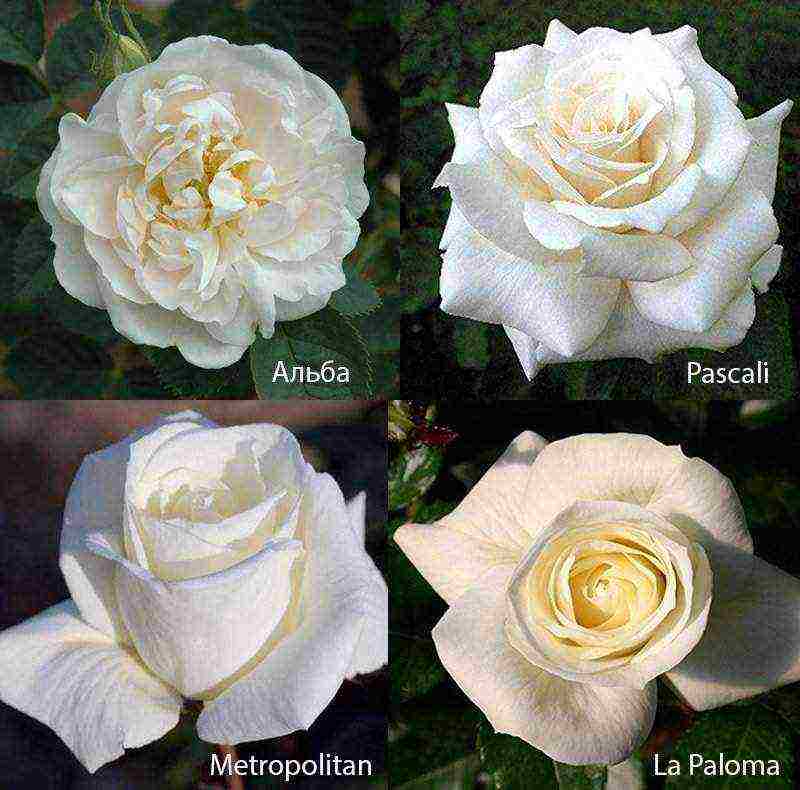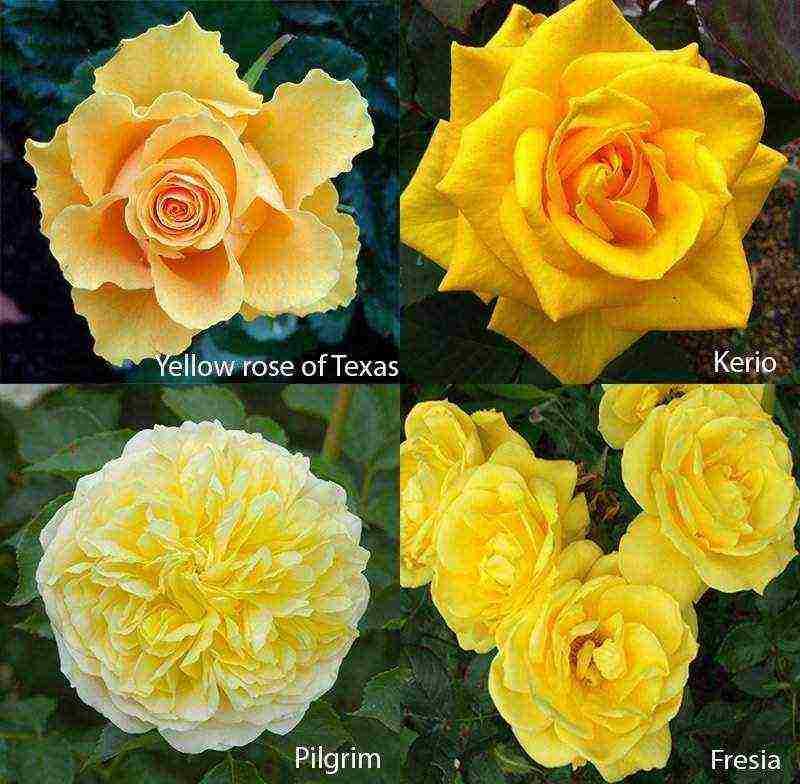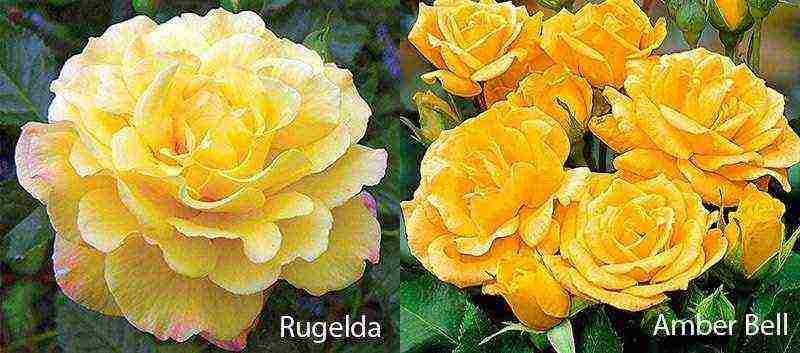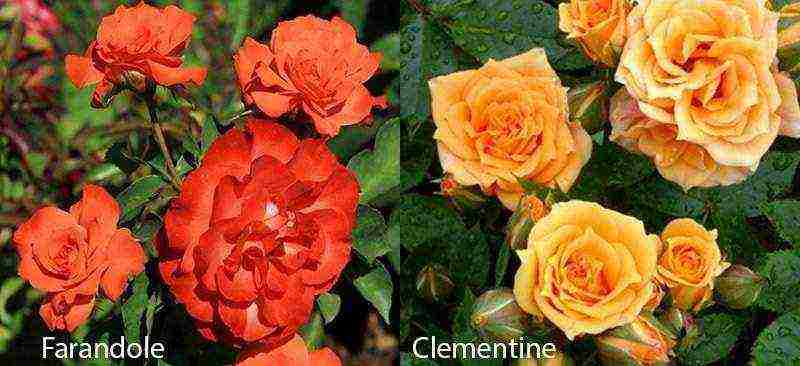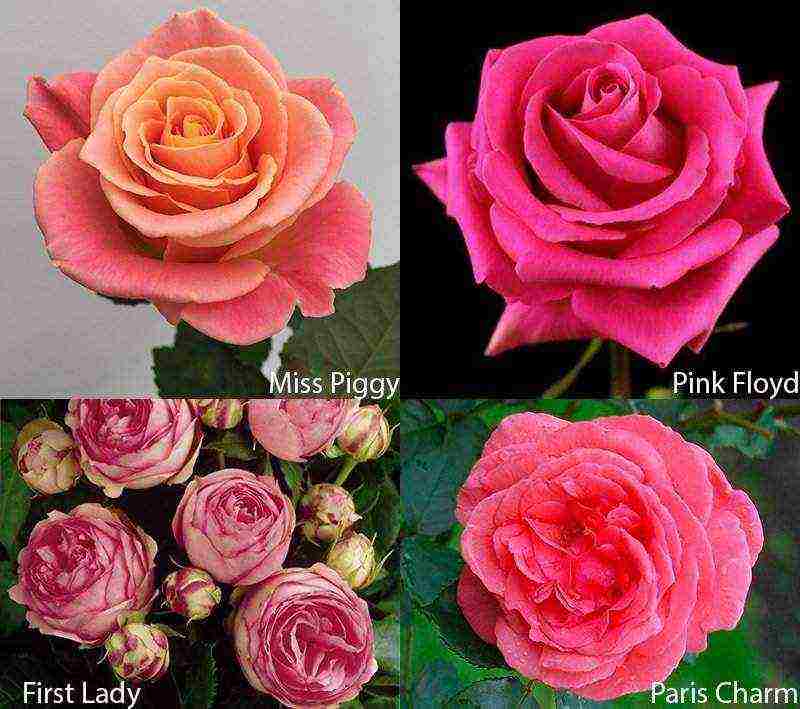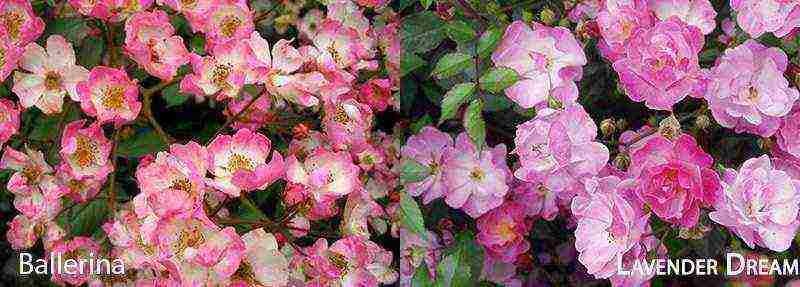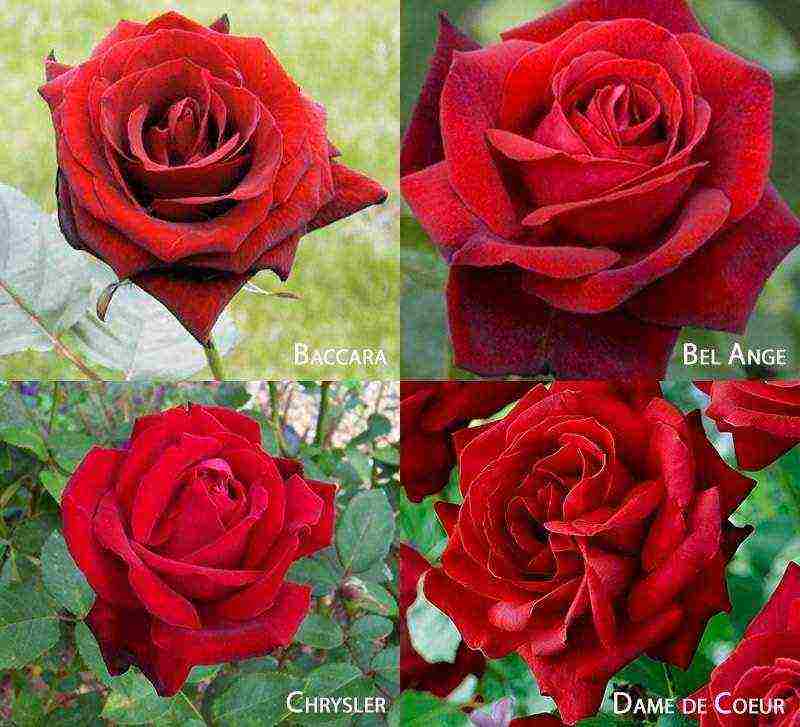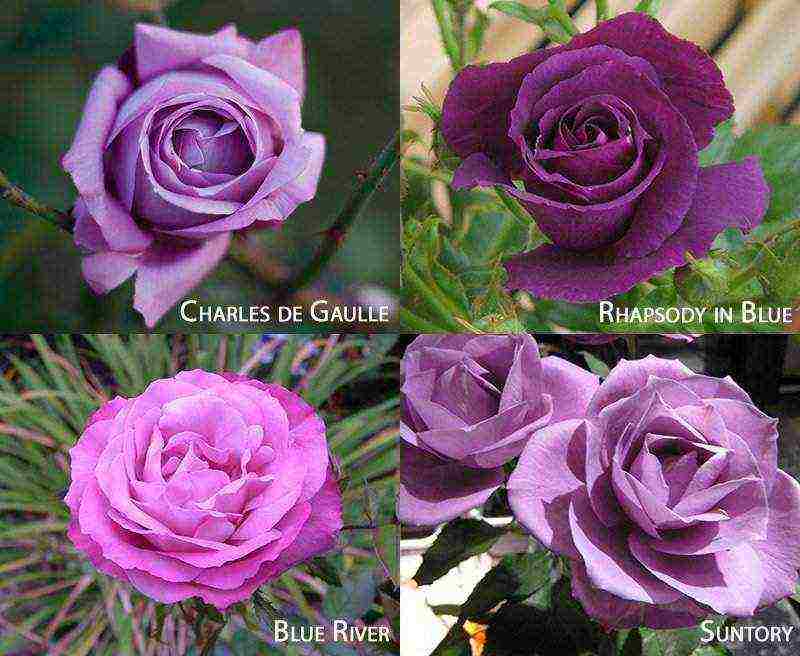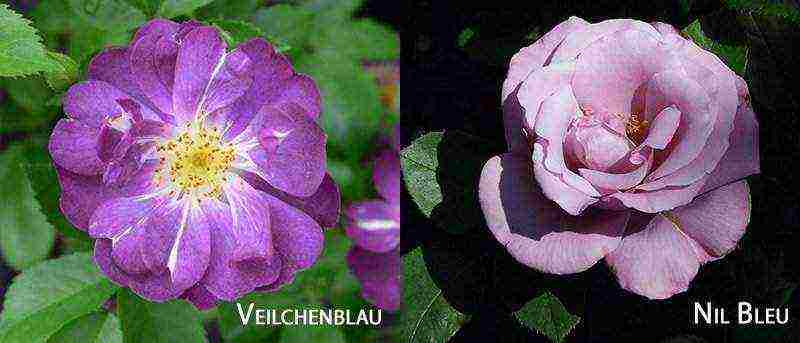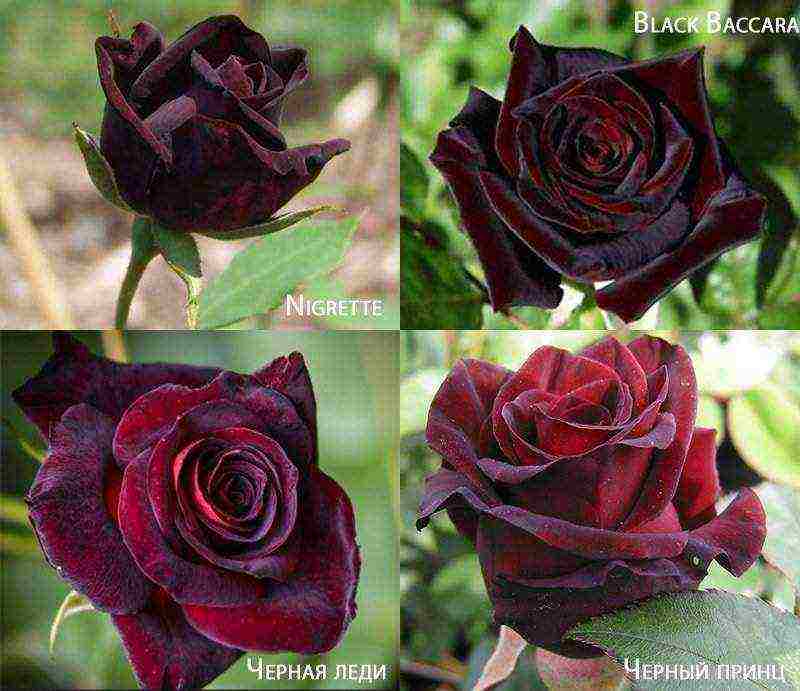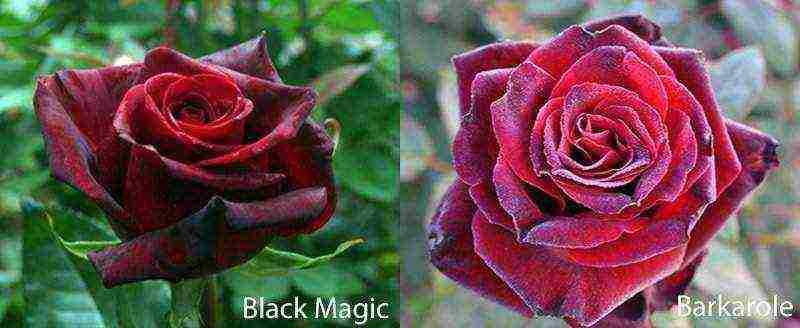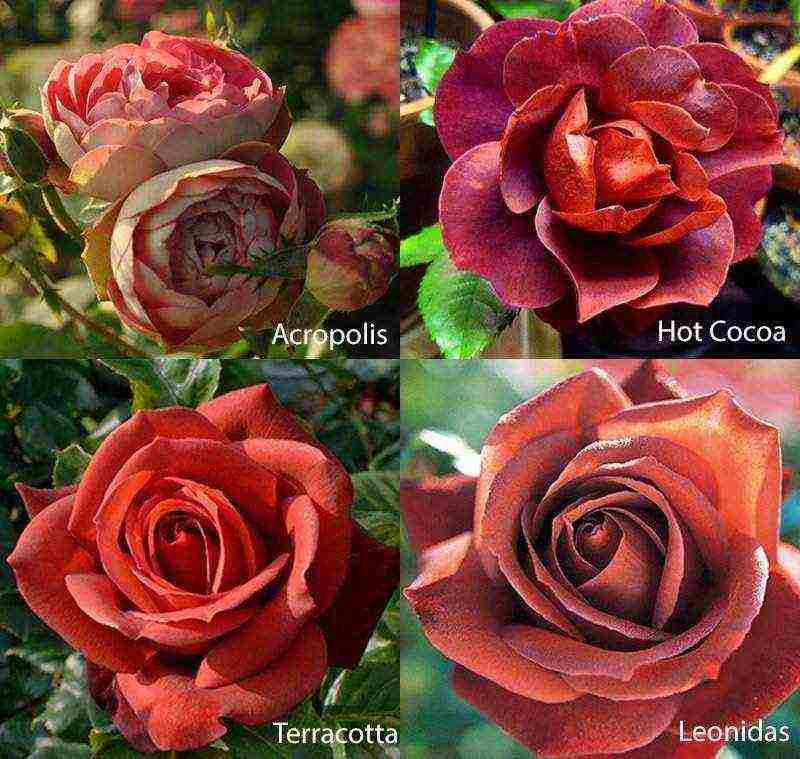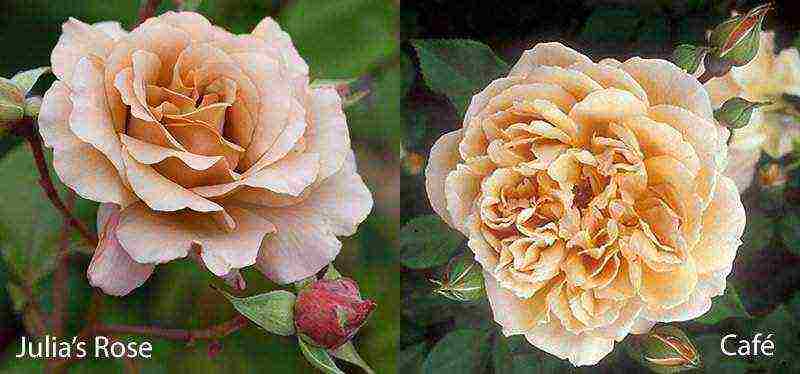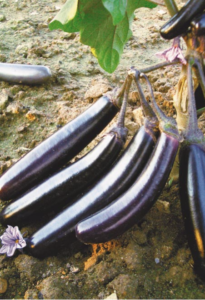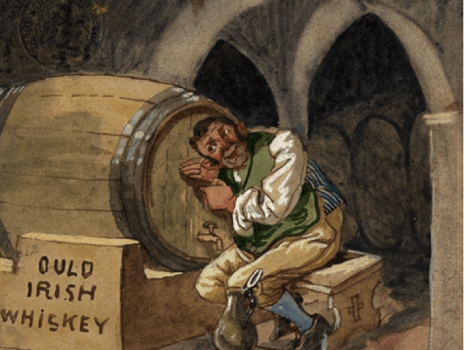Content
Summer residents and gardeners love to decorate their backyards with flowers. In many courtyards, you can see large flower beds and flower beds. Some people even create indescribable beauty from flowers, forming flower beds of continuous flowering. One of the main beauties is the rose. She is rightfully considered the queen of the flower world. It is she who, to a greater extent, is given special preference by both amateur gardeners and professionals. Therefore, many people want to choose the best varieties of roses. How to make the right choice and what should be considered?
The main criterion for the abundant flowering of the bush is the environment and soil characteristics. As many gardeners note, no matter which variety of roses is chosen, you can create a fertile soil for it yourself and concentrate the beds anywhere you want. Thus, the problem with the difference between the flowers you like and the soil conditions unsuitable for them is solved.
Roses with so-called complex colors are very demanding to the composition of the soil. The petals of such flowers have a combination of several shades. They can be very different and combine smooth or sharp transitions. Modern breeders have learned to breed amazing species of this plant, which have not only a complex coloring, but also an incredible shape. On unsuitable soil, such plants acquire a depressed state, an unsightly shape and a dull color. Their life cycle is significantly shortened.
Very often people choose David Austin roses. The varieties of these flowers are intended mainly for cultivation in partial shade and in loamy soils. Such conditions are typical for many other species. If we consider in general the soil conditions and the location of the flower bed, then these flowers love light breathing earth. It is categorically impossible to plant seedlings in clay, sandy and sandy loam soil, since it poorly permeates moisture and, practically, does not allow air exchange between the root system and the soil. Experts recommend, in this case, to carry out a double digging with the addition of chernozem, peat, sod land and well-rotted manure. In this case, the proportions should be kept approximately equal.
The best place to plant roses is on the southeast side of your patio, garden or backyard. The place should not be dark, shaded by buildings, trees or ornamental shrubs.
As for the climate, then one should take into account the resistance of a particular plant species to changeable weather conditions, to cold, heat and lack of air humidity. Are absolutely contraindicated for the colors of the place of north-western orientation at the summer cottage. Plants are very sensitive to drafts and cold winds, so roses will not grow well in such areas.
Classification of varieties of roses. What types are there and how to distinguish between them?
The opinions of many experts and florists boil down to the fact that before you start growing these beautiful flowers, you need to find out as much information as possible about them in order to avoid mistakes. After all, in the end, every grower, regardless of qualifications, wants to get high-quality, fragrant and beautiful roses. Species and varieties are divided into several categories. In each of them, there are the best options that have proven themselves positively in all respects.
The most beautiful and common types of roses are:
- Floribunda.
- Hybrid tea.
- Grandiflora.
- Groundcover.
- Climbing.
- Shrubs.
- Selected by David Austin.
When choosing a variety, you must take into account your preferences and tastes, then your favorite flowers will appear on your personal plot.
Floribunda roses. Varieties, photos, description
The history of these flowers began in 1924, when the Danish originator by the name of Poulsen first bred the original flowers of this type, which were called hybrid-polyanthus. At first, they belonged to the general category of tea roses, and were bred into a separate group in 1976. Some experts note that floribunda roses are intermediate varieties between the two types (hybrid tea and climbing). A distinctive feature of these colors is the diversity in everything. This is especially true for the combination of shades and tones. As a rule, they are rich, colorful, juicy.
General characteristics. The height of the bushes varies from 40 cm to 1.5 m, about 35 inflorescences can be collected on one stem. The flowers themselves have from 8 to 24 petals, the edges of which are distinguished by medium doubleness. In shape, some varieties resemble a narrow or wide glass, while others can bloom with flat or cupped buds.
The description of floribunda rose varieties also shows that their individual specimens can have golden, crisp shades that are distinguished by a glossy surface and rigid petals. Such plants have an average height (about 1 meter). They are also characterized by larger flowers, which are collected in small inflorescences.
It should be noted that floribunda is a continuous flowering rose. They are also resistant to frost, fungal and viral diseases. This is an excellent solution for decorating your summer cottage or home yard.
The best floribunda roses, varieties with photos:
- Golden Vedding (Golden Wedding) German selection.
- Samba. Germany, selection W. Kordes.
- La-Paloma (La Paloma). Germany, breeding Tantau
- Lion-Rose. Germany, selection Kordes.
- Leonardo da Vinci. France, breeding Meilland.
- Tchaikovcki. France, breeding Meilland.
- Gebruder Grimm. Germany, selection Kordes.
- Pomponella. Germany, selection Kordes.
- Jubile du Prince de Monaco. France, breeding Meilland.
- Koncerto (Concerto). France, breeding Meilland.
- Purpl Tiger (Purple Tiger). France, breeding Meilland.
Hybrid tea roses: varieties, photos, description
This group has a very interesting history. Back in 1867, the Frenchman J.-B. André Guillot was engaged in the cultivation of flowers that were unique at that time. He experimented with La France for years, crossing remontant and tea roses. As a result, he created a wonderful plant that had many differences and its own unique zest. Then André Guillot positioned his brainchild as a variety of bourbon roses.
In the description of varieties of hybrid tea roses, their main feature is listed - the continuity of flowering. Also characteristic of these flowers are easily-cranked or straight stems, which have increased strength. They create erect, slightly spreading shoots. The varieties of hybrid tea roses were classified into a separate group in 1997.
The bushes are characterized by low shoots. Their length is a little less than a meter, they have large racemes with 4-7 leaves. Most often, flowers are collected in small inflorescences of 4-6 pcs. The shades are very different (in some varieties, several colors can be combined). There are new varieties of hybrid tea roses that have complex large double flowers.
Almost all varieties of hybrid tea roses have a beautiful appearance and are perfect for decorating not only a summer cottage, but also premises. The average period of initial, active flowering lasts about a month. Then comes the time to move to the next stage - the emergence of new flowers (15 days for early varieties and 30 days for later). Then they bloom continuously until the first frost.
The best varieties of hybrid tea roses:
Medium-sized varieties:
Red-pink varieties:
Rose varieties of the Grandiflora group
A relatively new type of flowers, developed for decorating gardens. They look like a low-growing tree, about 1.5-2 m high. This group of flowers was obtained by crossing floribunda and hybrid tea varieties.Grandiflora embodies the best qualities of these varieties. They have a very attractive appearance and a wonderful aroma. Notable properties are resistance to disease and frost.
The best varieties of Grandiflora roses:
Ground cover roses: varieties, photos, description
The name of this group contains the main answer to the question about the main characteristics of the plant. Groundcover - low-growing roses that are able to cover a vast area of the flower bed with long shoots with many flowers blooming on them. The length of the shoot can at times reach up to 4 meters. Thus, nature creates a natural, beautiful carpet.
There are also ground cover roses, varieties of which, in addition to creeping on the ground, shoot drooping shoots. This type of growth provides an indescribable beauty to the bushes. Some species bloom once a year (they are rarely used by summer residents). It is the continuously flowering varieties of ground cover roses that are very popular.
Roses also have ground cover varieties (see photo), which are characterized by a variety of shades (light pink or pale crimson, red and dark red, light red or pure white). The buds have a variety of sizes.
Another feature of these flowers is frost resistance. Many varieties do not shed their foliage until spring. They are good for decorating columns or walls in the yard. Despite this, the base of the plants should be covered for the winter.
Ground cover roses, winter-hardy varieties (photo):
Roses shrabs: varieties, photos
Speaking about this group of flowers, one can note their main feature - a magnificent aroma, neat, upright bushes, abundant and continuous flowering. Flowers can be of various shapes (there are small ones, and there are large ones, the diameter of which reaches 12 cm). Petals are double, semi-double or simple. The leaves do not have a glazed surface; they can be dark green with a burgundy tint.
It should be noted that shrub roses were introduced into a separate group in 1954. It was then that many very beautiful species of this plant appeared.
Due to its structure and powerful root system, the formation of a bush is very easy, the main thing is to cut it on time. For example, flower growers very often form a ball, cone or strict square. This is not difficult to do. Some summer residents use this plant to form a decorative hedge to highlight one or another area of the personal plot.
Roses are grown shrabs (see varieties with photos) summer residents, both in separate flower beds, and in combination with other types of flowers. They are often used in the planning of gardens or parks, which is why shrub roses are called landscape or park roses.
There are three groups of scrub (park) roses:
- Curly - the length of the shoots is from 5 to 16 m.
- Climbing - shoots length up to 6 m.
- Semi-plaited - the length of the zero shoot reaches a little more than 3 m.
Erect bushes can reach heights of up to one and a half meters. Among the advantageous properties is frost resistance (especially Canadian park roses, the varieties of which can withstand a temperature drop of up to 350 C of frost). They bloom all summer until late autumn continuously, delighting the eye with their indescribable beauty and aroma.
The best varieties of scrub roses:
Roses bred by David Austin
The origin of this group of flowers is very interesting. An English breeder named David Austin began breeding completely new types of roses. He experimented for a long time, crossing classic floribunda and tea hybrid with varieties of long-forgotten old French and Damascus roses, which have already lost their popularity and demand among gardeners and summer residents.
As a result of his hard work, flowers of a completely new format were obtained, which began to be called Austin roses. The varieties he bred have very attractive shapes, with intricate petals and the structure of the bud itself. They are also characterized by new aromas. Many experts compare the smells of these flowers with the aromas of expensive, natural and real teas.
The best varieties of Austin roses are very beautiful and are often grown for the trade. Despite the variety of forms of shoots, bushes and an abundance of flowering, the presentation of all varieties of rose leaves is not lost.
The work done by the English breeder has a great price. For example, breeding a single resistant variety requires 4 to 8 years of diligent attention and careful approach. Austin devoted his whole life to this business, which is more than 60 years. From a very young age, he started a business that brought him the most pleasure. The nursery he created, which is located in Shropshire, is still engaged in breeding new types of Austin roses. The catalog of varieties with photos is constantly updated with new types of these flowers, which have incredible beauty and advantageous properties.
It should be noted that the climatic location of Shropshire (western England) contributes to the endowment of Austin flowers with unique properties - resistance to severe weather conditions and diseases.
Austin roses, photo varieties:
Climbing roses: continuously flowering varieties
According to the description and characteristics, the budding and flowering phases of these beautiful plants are very extended. Shoot formation occurs constantly. This property contributes to the continuity of flowering. This period can last up to six months without interruption. Paying attention to this feature, many designers and flower growers use them to decorate complex and simple building elements of their homes and courtyards. The best, in this regard, are Climings or Banks.
Also, varieties of climbing roses that grow all summer can be divided into three groups according to the nature of their growth:
- Curly. The length of the shoots is up to 15 m.
- Climbing. Shoot length up to 5 m.
- Semi-plaited. The length of the branches does not exceed 3 m.
This classification is not accidental. The fact is that claimings bloom on young shoots, and ramblers use branches from past years. The approach to plant breeding and the formation of a beautiful, climbing bush depends on this nuance.
The most beautiful varieties of climbing roses:
This article provides a description and photo of the most popular, beautiful, fragrant and original varieties of roses. Therefore, flower growers and summer residents have a good opportunity to purchase those flowers that best suit his tastes and requirements.
It is not for nothing that the rose is called the queen of flowers, without her a garden is not a garden. The choice is now huge, there are more than 30 thousand varieties in the world, and about 100 new ones appear every year. These beauties are sold in all nurseries and garden centers, but not in every garden they can be found. Although many tried to grow, but some gave up: too whimsical.
In fact, roses are not that difficult to care for. You just have to choose the varieties that are suitable for our harsh conditions.
The well-known rose collector, Muscovite Alexei Stepanov, tested many different roses on his site and compiled a list of the most reliable ones. It included 30 varieties. And they all meet 5 main criteria:
1. Excellent health. This is one of the main qualities, since a sick rose does not just spoil the appearance of a flower garden, it also hibernates badly. Or even dies. After all, the affected leaves fall off ahead of time, and the plant simply does not have time to ripen.
2. Stable wintering. In different areas, in different conditions and with different shelters, they are still able to survive our severe frosts.
3. Abundant and long flowering. There are no such roses in nature to bloom without interruption all summer, but these varieties will inflate as long as possible.
4. Resistance of flowers to bad weather. They are not afraid of rains, moisture and heat - in any case, they retain their decorative effect.
5. Good shoot regrowth. This is important when the aerial part of the plant dies after an unsuccessful wintering. After all, the more new stems grow, the more flowers there will be.
So, roses that won't let you down.
Hybrid teaGloria deiMeilland, 1945 This unsurpassed masterpiece is called the number 1 rose in the world. She is really magnificent: her flowers are large, yellow with tints and pink edging of the petals.
The only drawback is that each flower lasts only 3 days.
Ingrid bergmanOlesen, 1984 Gorgeous, dark red, with almost black buds - this is without exaggeration the best red variety for the middle strip. Perfect and inimitable. The bush grows quickly, the flowers last up to 2 weeks and are not at all afraid of rains.
AphroditeTantau, 2006 No wonder this rose was named after the goddess of love and beauty - she is the embodiment of beauty! Her flowers are 10–12 cm in diameter, porcelain-pink in color. They tolerate rain well. The bush is low, up to 80 cm.
Hommage a barbaraDelbard, 1997 Perhaps the best rose in the Delbard collection. Her flowers are delightful burgundy with black bloom and wavy petals. Each shoot blooms 1 bud, but there are always a lot of stems on the bush, the flowers last up to 2 weeks and are not at all afraid of rains.
FloribundaThere are 7 varieties in this group at once. They are delightful. They are resilient. They will decorate any garden!
Sangerhause jumbileumroseKordes, 2003 Its delicate, large (up to 9 cm in diameter) flowers in apricot-pink tones look very impressive against the background of dark green foliage. Branched bush. Not afraid of disease, heat or rain. Blooms all summer and is very abundant.
Leonardo da VinciMielland, 1993 As you know. Leonardo da Vinci was the greatest artist and ingenious inventor. And the rose, named in his honor, as if seeks to justify the high honor shown to her. Her bush is straight and compact. In the first bloom, it is literally strewn with bright pink pom-pom flowers, very close in shape to the old varieties.
The only drawback of this beauty is that she almost does not smell. But it never fails.
Lios-roseKordes, 2002 She is always included in the top ten charts compiled by a survey of rose lovers - in terms of reliability, she is not equal! Cream-white flowers bloom slowly on large clusters and change shape daily.
The disadvantage of a rose is that in the middle lane it wakes up much later than other roses, develops slowly and blooms only at the end of July. Therefore, the second time does not have time to bloom. But in our harsh conditions, this disadvantage turns into a huge plus, because, failing to plant the buds again, the rose has time to prepare for the cold and always winters well.
PastellaTantau, 2004 The bush of this wonderful variety is very beautiful, with bright dark green foliage. Flowers 7–8 cm in diameter, unusual creamy white color with pinkish and green tints. They are collected in multi-member clusters that bloom profusely and continuously. The rose has excellent health and winters well.
Jubile du prince de monacoMielland, 2000 The main advantage of this rose is its "long-lasting" flowers, each of which lasts up to 2 weeks and at the same time constantly changes color: at the time of dissolution, they are white with a red edging, then turn red, and as they fade, they become white-green.
The rose has two drawbacks - it does not smell and in unfavorable years it is affected by black spot. But on the other hand, it feels great in gray latitudes.
Gebruder GrimmKordes, 2007 This rose has been awarded the ADR quality mark, which is awarded to the most decorative and resistant varieties. Her flowers are of a unique yellow-orange-red color. Small, 6–7 cm in diameter, but always collected in large racemes. It always creates a bright accent in the garden, so it is better to plant it separately from other roses, for example, against the background of conifers. Otherwise, she will draw all attention to herself and other varieties next to her will be lost.
PomponellaKordes, 2005 She is short, but blooms very profusely. Her flowers are small, pom-shaped, intense pink, collected in large brushes of 15-30 pieces!
ShrubsThis group also has a fairly extensive selection of stable and unpretentious roses - 7 varieties that will not let you down and will delight you with health and abundant flowering.
WesterlandKordes, 1969 Very spectacular and unusual rose - her bush grows quickly and blooms in two pronounced waves. The flowers are semi-double, copper-orange. And although each of them lasts only 3 days, they take in quantity - there are a lot of buds in the brushes and new ones are constantly replacing the fallen ones. In very harsh winters, it can freeze slightly, but quickly recovers.Possesses the ADR quality mark - for high decorative effect and durability.
AngelaKordes, 1984 The flowers of this wonderful rose are medium-sized, up to 4 cm in diameter, but an incredible amount of them is formed. They are bright pink in color, collected in numerous brushes, which cover the leaves. In catalogs in photographs, she usually does not look very presentable, and flower growers often bypass her with their attention. But those who planted were not disappointed - this is a real queen! Nothing sick and all in bloom. No wonder she was awarded the ADR quality mark.
Bonica 82Mielland, 1985 The ideal rose for beginners! She easily forgives mistakes in pruning and shelter for the winter, and every summer she pleases with abundant flowering. Her flowers are light pink, slightly fading. They are not large, 5–6 cm in diameter, but they open constantly, in any weather, right up to the snow!
The only drawback is that it doesn't smell at all.
Rhapsody in blueFrank R. Cowlishaw, 1999 This is the only blue rose in the top 30. And this is the bluest of all roses! More precisely, it is blue-violet. The flowers are not large, but collected in large brushes. Rain resistant. The bush grows up to 1.5 m and looks very impressive surrounded by dense yellow roses.
Louise Odier (Madame de Stella)Margottin, 1851 Notice the year it was bred - it is over half a century old! This is an old Bourbon variety that will give odds to many modern ones. Very hardy and winter hardy. It can even be left without shelter in the winter. The bush, of course, freezes above the snow level, but quickly recovers. With good cover, the plants are tall and very dense. The flowers of this rose are of an old cupped shape, 5–7 cm in diameter, dark pink in the center and lighter at the edges. And what a smell! Saturated, strong. By the way, it is from this variety that rose oil is most often made and jam is brewed.
LarissaKordes, 2008 It appeared on the market relatively recently, but has already managed to conquer gardeners with excellent health and abundant flowering. Its flowers are small, 5–6 cm in diameter, pale pink, densely double, old-fashioned, collected in large brushes. This variety will perfectly complement English roses with large flowers.
Guy SavoyDelbard, 2001 The only rose with striped petals to make it to the list of trusted varieties. It is so powerful that in France it is recommended to make hedges from it. In our conditions, it is, of course, a little more modest, but, nevertheless, it grows up to 1.5 m, forming very tough shoots. They cannot be bent down for the winter, so the bush has to be cut to the height of the shelter. The flowers of this rose are weakly double, but large, of a rare pomegranate shade with white strokes. Each brush contains 9–20 buds.
EnglishThis group included 5 varieties that showed themselves at their best in the harsh conditions of Russian reality.
Graham thomasAustin, 1983 This is one of the best varieties of selection by David Austin. Several years ago, he was the last, 14th in a row, to take a place in the World Rose Hall of Fame. It blooms very profusely. His flowers are bright yellow, do not fade and are considered the standard of yellow in roses. In our climate, it will grow very quickly, reaching a height of 2 m.
Crown Princess MargaretaAustin, 1999 An incredible variety - during the flowering season, its shoots are covered with caps of densely double light orange flowers of an old shape with a strong aroma. It can be grown like a climbing rose, with minimal pruning, keeping the shoots from last year. In this case, it will bloom almost along their entire length.
James galwayAustin, 1985 This variety in warm countries forms a powerful bush 2 m high and the same size in circumference. However, in Russia it does not work that way - the shoots are very hard and it is impossible to bend them to the ground, so you have to cut them to the height of the shelter. The flowers of this rose are cold pink, very fragrant, collected in a brush.
Mary roseAustin, 1985 This is one of the first varieties that brought David Austin worldwide fame. The qualities of the variety are outstanding. Tall and strong arched shoots create a beautiful bush shape. They fit easily for wintering.Cold pink flowers with a lilac tint fully convey the charm of real old roses. One of the first to bloom in the garden, and one of the last to finish flowering.
Crocus roseAustin, 2000 The most popular flowering rose in our country. A powerful, spreading bush grows quickly - this variety has never had problems with replacing shoots. Her flowers are white, with an orange center - they look just amazing!
GroundcoverThere is only one variety here - only it has fully shown itself to be reliable and very decorative.
Sunny roseKordes, 2001 This variety fully justifies its name ("sunny" in English means "sunny") - if you want to have a yellow carpet in your garden, then it was created especially for you! Pleases with abundant, almost continuous flowering. In brushes up to 12 large rich yellow, fading to creamy flowers. An adult bush covers an area of about 1 sq. m. It has the ADR quality mark.
ClimbingThere are quite a lot of reliable roses in this group - 6 varieties at once have shown themselves at a height in our difficult climatic conditions.
FlammentanzKordes, 1955 A very spectacular rose with red petals. It blooms once, but so abundantly that it literally overshadows other roses! Her flowers are resistant to rain, open in any weather and stay on the bush for a long time. It grows well on its own roots and perfectly cuttings, therefore it wanders from garden to garden.
Rosarium UetersenKordes, 1977 Growing fast. It blooms profusely all season with bright crimson flowers. It is considered a petite, but in our climate it does not grow to the declared size and is usually grown as a scrub. Looks great and blooms on a trunk. Over time, its shoots become thick, they are difficult to lay, so the bush for the winter has to be cut to the level of the shelter.
Pierre de Ronsard (Eden Rose)Mielland, 1987In our conditions, its lashes reach 1.5–2 m. It looks beautiful on a lattice support, if you distribute the shoots on it in the form of a fan. But you can grow it in the form of a bush, tying it to vertical supports to protect it from the wind. By the way, it is often called the “rose of paradise”. Indeed, when you stand near an adult flowering bush, which is adorned with an abundance of creamy white flowers with a bright pink edge, it seems that such beauty can only be in paradise.
But this rose has 3 drawbacks: weak aroma, instability of flowers to rain, and thick shoots, which have to be bent for the winter in 2-3 doses.
JasminaKordes, 2005 This rose amazes with excellent health and abundant flowering - new shoots have caps of up to 50 buds! The flowers are medium-sized, cup-shaped, with the most delicate pink-lilac tint and an amazing aroma! And what is more pleasant - the shoots fit well in the winter.
Dorothy perkinsJacksaon & Perkins USA, 1901 It is not without reason that this climbing rambler rose has been so popular in the world for more than 100 years - its powerful bushes 3 m high and more than 2 m wide are strewn from top to bottom with cascades of small, 3-5 cm in diameter pink flowers. The foliage is small, glossy and completely covered with flowers during flowering. Blooms once. Looks great on a high trunk - its long shoots gracefully hang down in a luxurious waterfall.
RaubritterKordes, 1936 This outstanding rose is over 80 years old, but it still drives flower growers all over the world crazy. Belongs to the group of ramblers. It blooms once, but very profusely. The flowers are medium-sized, 5–6 cm in diameter, and resemble pom-poms in shape - they seem to have descended from old paintings. The shoots are very thorny and flexible, easily bend in any direction, so there are no problems with laying them for the winter.
P.S. Please note - most of the roses in the list of the rose collector Alexei Stepanov belong to the selection of Cordes. And this is not surprising, because the climate in Germany is closest to ours. Heat-loving French women are still lagging behind in disease resistance. And one more thing: in this list of reliable roses, as you noticed, there are no varieties of Canadian selection. But they are ideally suited for our harsh conditions. Yes, only their decorativeness, to put it mildly, for an amateur.
Based on materials from the magazine "Gardener Bulletin", April 2013
Rose is a beautiful flower with a delicate aroma and spectacular appearance that can revive even the most dull flower garden. The variety of shapes and palettes of this plant allows you to advantageously arrange a different landscape of the site, carry out vertical gardening, grow a hedge or reproduce the royal greenhouse at home. Hardy roses can decorate the rose garden or front garden of site owners in cold areas.
Winter hardy roses varieties
Rosa is a Latin collective name in botany for representatives of the Rosehip genus, the Rose family, or Rosaceae. It is impossible to call this flower unpretentious. For a seedling, it is necessary to carefully select a place, lighting, soil. Requires constant care for them throughout the season. Obligatory procedures for such a pet to be healthy, actively develop and bloom regularly, are constant treatment against various microbial, fungal diseases, insects, balanced and timely feeding, pruning.
Read more about Caring for the queen of flowers - a rose.
Most of the wild species live quietly in the climate of the middle zone and endure frosty winters with almost no damage. Cultivated species are not so immune to cold, so growers often suffer losses. To solve this problem, scientists and botanists have resorted to selection. The result of their labors was winter-hardy varieties of roses.
After carrying out the necessary preparatory work on the site, the question arises of which winter-hardy roses should be purchased. The wide assortment in garden centers and specialized stores will not disappoint the consumer. Further, the most unpretentious and winter-hardy representatives of the family will be considered.
Video “How to lay a rose garden correctly
Climbing roses
Frost-hardy climbing roses can be represented by small-flowered specimens like rose hips and new large-flowered species that bloom several times per season and have striking colors.
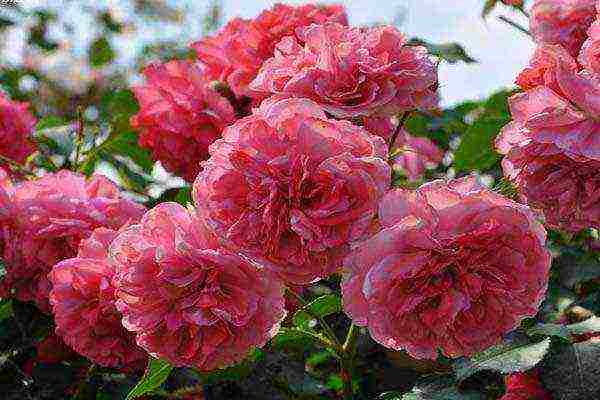
Climbing rose variety "Rosarium Utersen"
Rosarium Uetersen Is a large-flowered representative obtained by growers in 1977. But popularity began to gain in the zero years. The buds reach 15 centimeters. The palette is limited to shades of pink. The lush and bushy crown bears fleshy foliage. They are planted on the south side, bearing from adjacent plants and supports (building, fence) by half a meter.
Large blooming "Santana" forms single buds up to 12 centimeters in diameter, or brushes of several flowers. The three-meter bush is completely covered with blood-red flowers and pleases the eye for a long time. The landing site should cover an area of 50 by 50 centimeters in the southern part of the territory. Planted in spring or autumn.
Big buds are dissolved by a rose "Polka" with a diameter of 15 centimeters. Delicate peach or cream color. Abundant undulating bloom several times a season. The bush is low - no more than 2 meters.
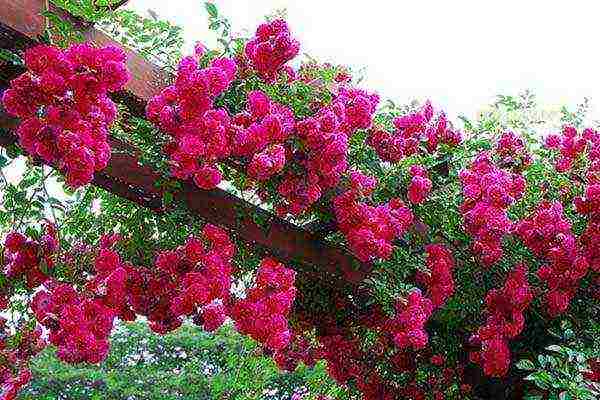
Winter-hardy climbing rose variety "Super Excelsa"
Small-flowered "Super Excelsa" leaves buds of no more than four centimeters, lilac color, almost purple. Terry flowers. It is advisable to determine the seedling in the shade, since the petals are very delicate and will quickly lose their appearance in the sun.
"Snow Goose" has miniature flowers that cover the bush continuously. Brushes can form up to 20 buds. The thorns are practically absent. The variety is used in vertical gardening and as an independent plant.
"Super Dorothy" - small-flowered with abundant flowering until the first frost, but the first flowers appear only by the beginning of summer. Reaches three meters in height. The palette has many shades, but the most popular color is crimson.
Austin roses
Austin roses are often called "Austin roses", "Austin roses". The first samples were bred by the famous breeder David Austin at the end of the 20th century, who destroyed the stereotype of the usual goblet rose and began to display buds of various shapes, inspired by the flowers of ancient roses.
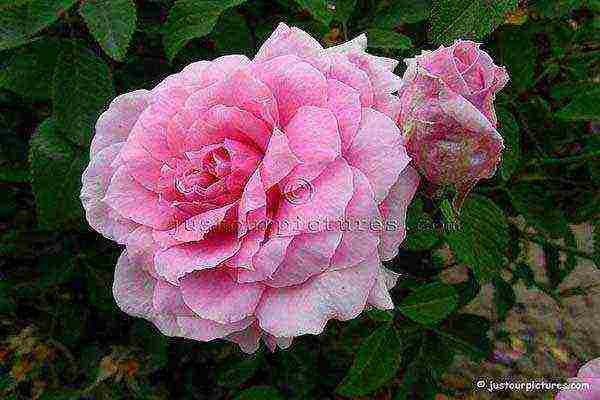
Austin roses variety "The Mayflower"
"The Mayflower" - the first representative of this variety, resistant to disease and frost, awarded a royal award. The flowers are soft and small, pale pink in color, with a strong pink scent. Flowering begins in spring and continues until the first frost.
Susan William-Ellis»Blooms at the end of May. White flowers stand until frost. They have a bright odor. Shrubs are suitable for planting curbs and hedges.
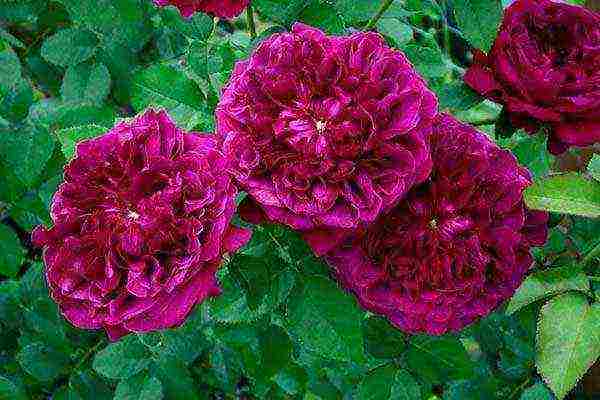
Austin roses variety "William Shakespeare 2000"
William Shakespeare 2000 - this is the most spectacular frost-resistant rose from the category "Austin roses". Forms a lush, dense and vigorous bush. The diameter of the flowers reaches 10 centimeters, which are collected in a brush. Each brush maintains flowering for up to two weeks. Greens are pure green in color. Lilac flowers become more saturated over time and darken by several shades.
Hyde Hall - large rose bush. Blooms for a long time. Produces a large number of buds. Due to its size, it can appear in the background or be grown as a hedge. It is very hardy, therefore it is capable of abundant re-flowering.
"Wild Edric" often mistaken for rugoza. Brushes are oblong and densely folded with semi-double flowers of deep pink color with purple tints. By the end of flowering, the rosettes fade to pale lilac. It has a light, unobtrusive aroma with a hint of cucumber.
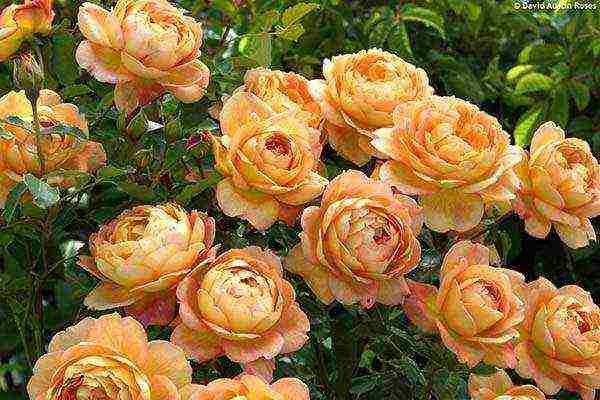
Austin roses variety "Lady of Shalott"
"Lady of Shalott" has flowers of unusual color. The petals are of a heterogeneous orange-pink-coral-apricot color with a pale yellow underside and a rich salmon-orange center. Despite such a delicate appearance, it is very resistant to diseases and frost-resistant. Under favorable conditions, it grows rapidly and forms large branches. The smell matches the color - warm, apple, tea and clove.
Graham Thomas Is the variety that has become the most popular among many yellow brethren. Few varieties, even among hybrid tea, have such a pure yellow color without shades. Cup-shaped double buds with a diameter of 7-10 centimeters exude a tea aroma. Forms a large bushy crown. Abundant flowering pleases the eye for a long time.
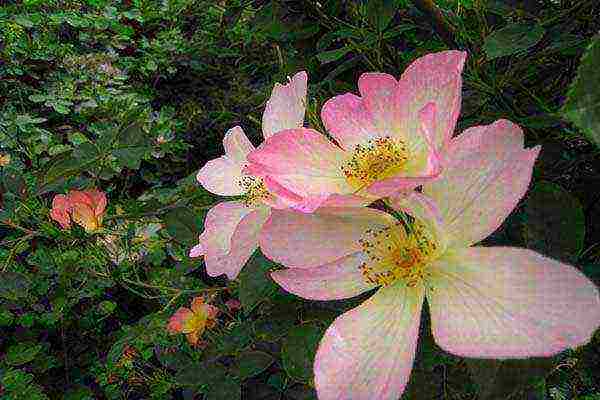
Austin roses grade "The Alexander Rose"
"The Alexandra Rose" - an uncharacteristic representative of Austin roses. The ancestor of this variety is the Alba rose. The flowers are similar to wild rose hips. In the center there are pronounced stamens. The color changes with age from salmon pink to almost white. The brush can be covered with buds, up to 20 units. The thornless crown has spreading shoots.
Benjamin Britten is a very effective rose bush with a coloration atypical for the English rose. The petals are bright red with orange notes and form a bowl around a deep-set center. It contrasts well against the background of more gentle brothers. The bush crown is formed by branchy shoots intertwined with each other. Has a bright aroma with reminders of pear wine and fruit.
Video "Austin Roses - a story about the history of their appearance"
Ground cover roses
Ground cover roses include many members of the genus in their group. Got their disease resistance and excellent frost resistance from wild rose hips. Do not need regular pruning. Easy to care for. A distinctive feature of this category of plants is the presence of long and winding shoots, falling and creeping in a carpet - hence the name.
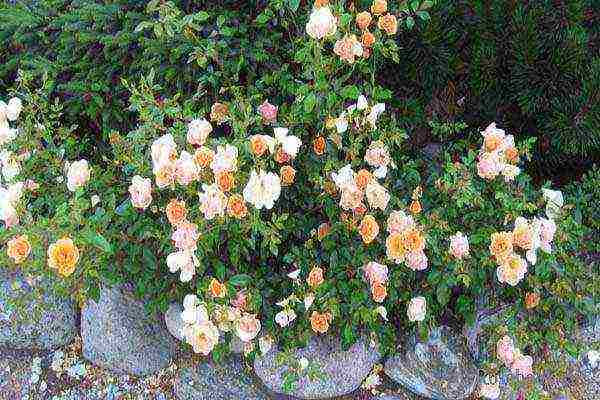
Winter-hardy ground cover roses grade "Amber Sun"
"Amber Sun" has a wide crumbling bush with shiny and fleshy greens up to half a meter high. The clusters are formed by buds, up to 8. Shoots densely cover the area around the bush. The petals are honey-yellow in color.
"Eskimo" ("Eskimo") - medium-sized scrub. The bush is erect, reaching a height of 80 centimeters, which allows the variety to be used as a hedge. Brushes are formed by small white rosettes up to 8 units. Very unpretentious. No pruning required.
Stadt Rom striking in its splendor.Fuchsia buds, not terry, like rose hips. About this they say: "Blossoms like crazy!". The crown is dense and compact with well-branching shoots.
Canadian roses
Canadian roses are sectioned by crossing the Rugosa with the species and Cordes roses. From the name of the group, it is clear that they were first bred in Canada for the appropriate climate. They are distinguished by high endurance of low temperatures (down to -40 ° C).
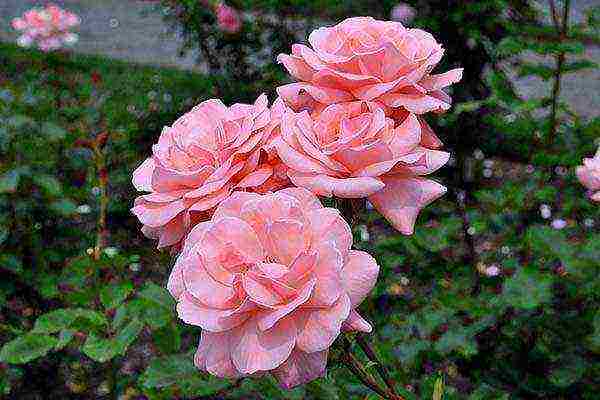
Floribunda rose cultivar "Queen Elizabet"
Queen Elizabeth has pale pink petals, tightly collected in a semi-double flower. They fade in the sun, losing color saturation. The buds form a large brush of up to 15 flowers. Every six years, it is necessary to carry out a rejuvenating pruning of the bush, which means removing the shoots almost at the root in early spring. It is the first representative of the "grandiflora" category, although this group is not recognized in all countries.
Arthur Bell - floribunda rose. It begins to bloom early. Repaired. Yellow petals fade under the rays, so it is worth shading, but not much. Smells like sweet fruit. Accustomed to the weather of Northern Europe.
J.P. Connell " - yellow rose from the Explorer collection. Petals are pastel lemon yellow. Does not form large brushes. In the center of double flowers in the shape of a bowl, red stamens "sit". Without pruning, the crown becomes vigorous. Produces undulating blooms.
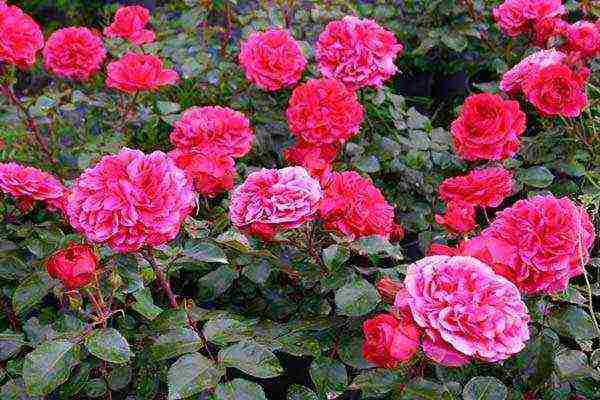
Winter-hardy roses grade "Leonardo da Vinci"
Shrub roses "Leonardo da Vinci" floribunda type. Abundantly flowering bush with very large flowers, juicy pink. Inflorescences are numerous with densely double flat flowers. Delivers a delicate pink scent. Despite the rich and aristocratic appearance, they act as very resistant specimens to the diseases "powdery mildew" and "rust".
Read also Unpretentious and beautiful - Canadian roses
Non-covering roses
Uncovering roses are refined rosehip varieties. These wild roses bloom once and produce juicy fruits.
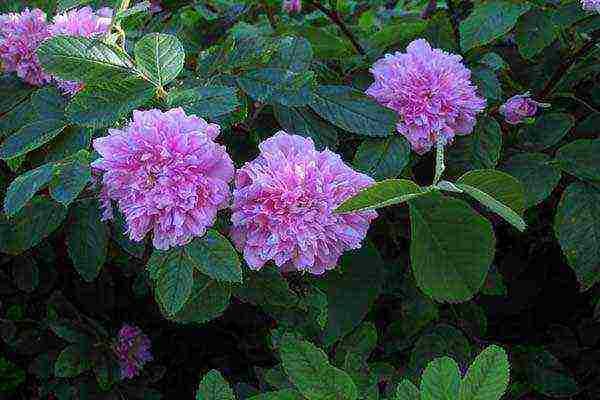
Non-covering roses grade "Tornedal"
"Tornedal" is of Scandinavian origin from Rosa majalis. The flowers are flat, double and small, pale pink in color. In the middle there are pronounced stamens.
Malva and Foecundissima also belong to Rosa majalis. Beautiful and easily growing bushes of these varieties are used in park landscaping and hedges.
Speaking of winter-hardy roses, their resistance to diseases and frost is often mentioned. This undoubtedly makes the work of the grower easier. However, cultivated roses are very capricious plants. When choosing even the most unpretentious variety, it is worth remembering that you still have to take care of it in order to get abundant flowering and ensure healthy growth of the bush. Serious immunity does not provide protection against insects, drought and heat, the "wildness" of the bush without pruning. Winter-hardy roses require careful shelter for the winter and the right place, otherwise severe frosts can still destroy the flower. Do not think that strong varieties of roses can grow on their own.
Video "Preparing roses for winter"
the Rose is considered the oldest flower in the culture of mankind, a rare floristic composition or a dacha flower bed does without the "queen of flowers". It is a shrub plant with arched or straight shoots covered with thorns. Flowers have a characteristic aroma, can be collected in inflorescences or single.
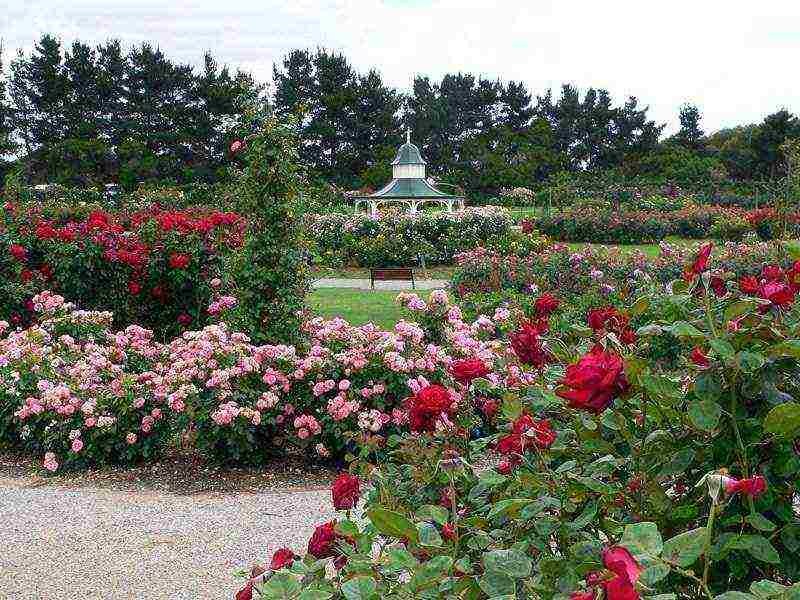
Types and classification of roses
It is difficult to classify roses, because there are about 30,000 varieties... The following classification is considered generally accepted:
- Wild plants (rose hips)... Shrubs, from 30 to 200 cm high, weaving or creeping along the ground. Most bloom once with simple flowers. They are undemanding to conditions and care, therefore they are very popular in summer cottages.
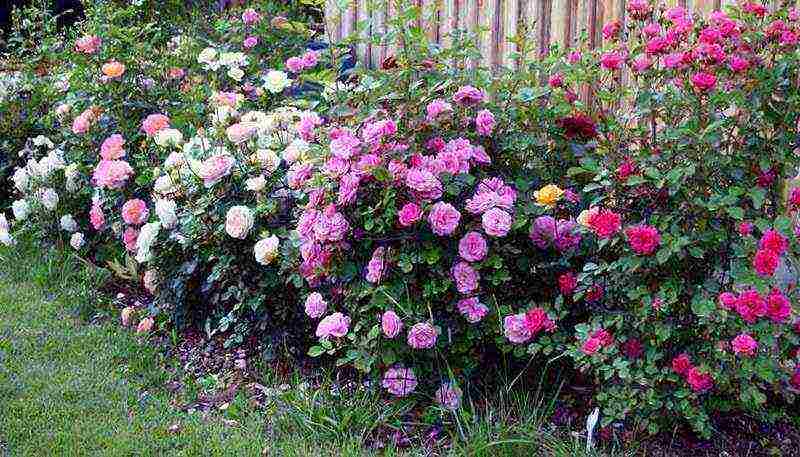
- Vintage park roses... Slender shrubs, up to 1.5 meters high. They have the ability to re-bloom, a pronounced aroma, and are resistant to diseases. The most famous representatives of this group are Damascus, Gallic, moss, and remont.

- Modern roses... The result of painstaking work of breeders, they grow up to 2 meters.This category includes climbing, hybrid tea, miniature, ground cover, shrubs and other varieties of roses.

Roses also differ in inflorescences, they can be:
- Densely double (more than 40 petals).
- Medium double (from 30 to 39).
- Moderately terry (21 to 29).
- Semi-double (from 8 to 20).
- Simple (4 to 7).
Now is the time to advertise our article, in which we have selected some of the best powerful garden pruners. They will be useful to you in caring for your beautiful roses. Choose the best from our selection and order on AliExpress.
What color are roses
|
White (may have blotches of other pastel shades) |
White Christmas, Pascali, Metropolitan, Arctic, Nema, La Paloma, White Dorothy, Alba. |
|
|
|
|
Yellow (pink and red shades may be present on yellow petals) |
Kerio, Yellow Rose of Texas, Pilgrim, Arthur Bell, Rugelda, Friesia. |
|
|
|
|
Orange (petals are orange, other shades may be present - yellow, purple) |
Gebruder Grimm, Farandole, Westpoint, Honolulu, Clementine, Marvelle. |
|
|
|
|
Pink (shades of yellow, orange, purple may be present on the petals) |
Miss Piggy, Paris Charm, Pink Floyd, Osiana, Lavender Dream, Ballerina, First Lady. |
|
|
|
|
Red (shades of orange, yellow may be present on the petals). |
Baccara, Valentina Tereshkova, Bel Ange, Chrysler, Dame de Coeur. |
|
|
|
|
Purple (have areas of lavender or purple hue). |
Rhapsody in Blue, Charles de Gaulle, Veilchenblau, Blue River, Suntory, Nil Bleu. |
|
|
|
|
Black (maroon color). |
Nigrette, Black Lady, Black Prince, Black Magic, Black Baccara, Barkarole, Black Tea. |
|
|
|
|
Brown (there may be a red tint on the petals). |
Hot Cocoa, Acropolis, Café, Julia’s Rose, Terracotta, Leonidas. |
|
|
|
|
Multicolored (have a variegated color of several shades that do not mix with each other) |
Alinka, Red Intuition, Abracadabra, Hocus Pocus, Athena, Alliance. |
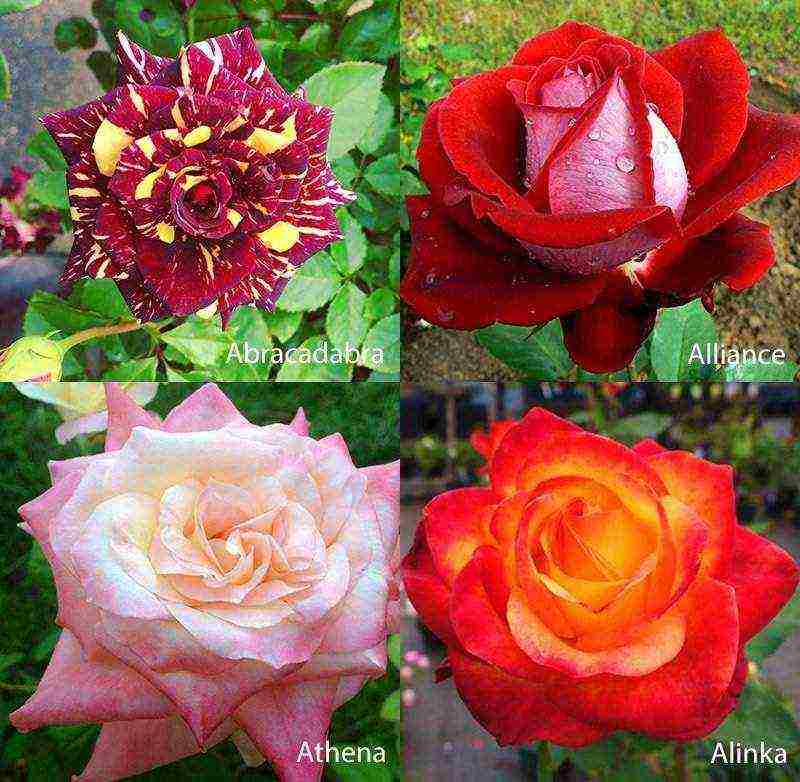
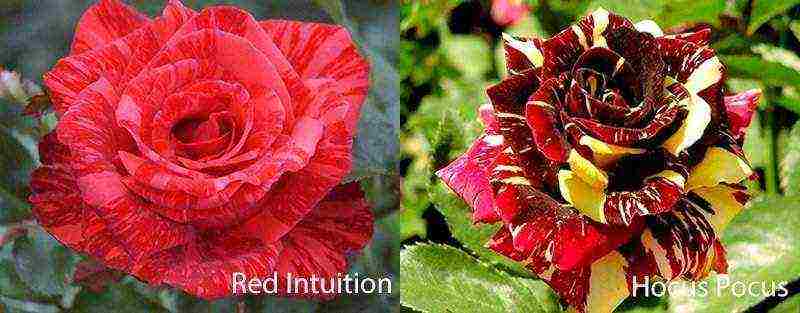
What do roses smell like?
The fragrance is felt most strongly in calm, sunny weather - this is due to the evaporation of aromatic oils under the influence of heat. On a damp and cold day, the smell is hardly noticeable.
What do roses smell like:
- Rose oil... This scent is typical for old varieties of roses (Damascus, Alba, Gallic). Sometimes it is complemented by berry and spicy notes.
- Berries and fruits... Bourbon rose Zephirine smells like apple, Marechal Niel smells like strawberries, Kiftsgate smells like vanilla and banana. Peaches and apricots smell mostly orange roses.
- Tea smell... Sweetish, with notes of fruit and muscat wine. Mostly in yellow and cream roses.
- Musk... This scent is released not by the petals, but by the stamens of the flower. The most famous varieties are Beauty, Pax, Felicia, Vanity.
- Herbs and spices... Interestingly, roses can smell like lavender, basil, anise, cloves and even vanilla. Agnes Schilliger smells like mulled wine, Fritz Nobis - clove sticks, Michel Bras - lime blossom and mint.
- Flowers and needles... The smell may contain notes of aroma of other flowers - lily of the valley, freesia, jasmine, lilac. Pierre Cacnaire is a variety that smells like bergamot, Mitsouko smells of violets.
Caring for roses How to care for roses at different times of the year
- In the spring... After the onset of heat, you need to remove the shelter from the bushes, carry out spring pruning and feeding. If the bushes often suffer from pests, it is worth treating them prophylactically.
- Summer... The most important period - it is necessary to ensure timely watering, loosen and mulch the soil, stimulate the flowering of the shrub.
- In autumn... The gardener's task is to prepare the roses for wintering. Gradually reduce watering and loosening of the soil, only weed. They prepare a shelter, do top dressing and pruning, protect the bushes from rodents, spreading the poison.
Planting and fertilizing
You need to plant seedlings after waiting for warmth. Roses are moisture-loving plants, they are watered abundantly in the morning or evening, avoiding blurring of the roots.
Every day, the bushes are watered until complete rooting, then - 2 times a week. Fertilizer is laid in a trench or pit for planting. In the future, the plant is periodically fed with organic and mineral fertilizers.
An overabundance of minerals can lead to petrification of the soil and inhibition of plant growth. Every month it is necessary to loosen and mulch the ground under the bush, with the onset of cold weather the soil is compacted.
Pruning roses
When planting in spring, the seedlings are cut in advance. In the first summer, buds are removed from the bush for the proper development of plants. It is important not to touch the leaves - they are essential for photosynthesis.
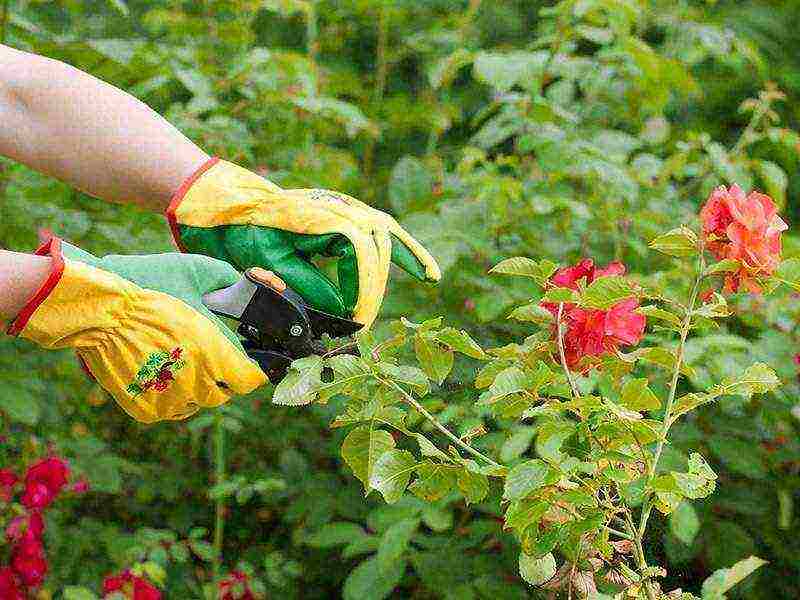
There are three ways to trim:
- 4 buds from the base of the stem... It is used to rejuvenate bushes, stimulate the growth of frail plants, newly acquired seedlings.
- 7 kidneys from the base... During the flowering period, garden roses become more magnificent.
- Trimming the ends of the stems... This method is used to stimulate the bush to bloom as soon as possible.
Important! The frequency of pruning depends on the type of rose: hybrid tea, floribunda are pruned annually. Scrub roses and ramblers shorten the shoots by a third by cutting out the branches inside the bush. For climbing roses, only five-year shoots are removed.
Shelter roses for the winter
With the arrival of night frosts, the rose is spud with a mixture of peat, earth and sand in equal proportions. The height of the resulting mound should be at least 25-30 cm. The shrub is pruned, shoots that have not matured are removed, and the frequency of watering is reduced. From above, the bushes are covered with cardboard, spruce branches, film. Sometimes they use special canvases - agrotex, lutrasil. When snow falls, you need to form a snow mound on top of the shelter - this is an additional protection from wind and frost.
The shoots of branching roses are shortened and bent to the ground, with a film spread over them to protect them from dampness. You can wrap the bush with the same film - then the spruce branches are not needed. With the onset of spring, the upper film is removed first, and the lower one when the ground is well warmed up.
For more information on planting and pruning and caring for roses, see this video:
Diseases and pests of roses
Pests are most dangerous during the growing season of the bushes. The most common are: rose scale and aphid, different kinds sawflies, May beetles, spider mite, caterpillars, slobbering penny, nutcrackers... They suck out the juice, infect young buds, leaves and shoots.
Signs of damage to roses:
- Leaves dry up or curl up into a tube.
- Plant growth slows down.
- Young shoots wither.
- The leaves turn yellow, a sticky bloom, cobweb appears on them.
- Spots appear (yellow, serous, etc.), which quickly increase in size.
The reproduction of pests is facilitated by high temperatures, poor plant care (neglect of soil mulching and hilling, lack of insecticidal prophylaxis).
Description and treatment of rose diseases
The most common rose diseases:
- Powdery mildew... Fungal disease, which is manifested by the appearance of a white bloom on the shoots of the bush. The leaves begin to curl, turn yellow and fall off. The affected leaves must be removed and burned, the plant should be sprayed with iron vitriol (300 g vitriol per 10 liters of water) or a copper-soap composition (100 g soap and 50 g vitriol per 10 l of water).
- Black spot... The causative agent of the disease is a fungus. The leaves are covered with dark brown spots, the edges turn yellow. The flower buds do not bloom and fall off. For treatment, you need to treat the bush with a 0.1% solution of foundationol, phytosporin and alirin.
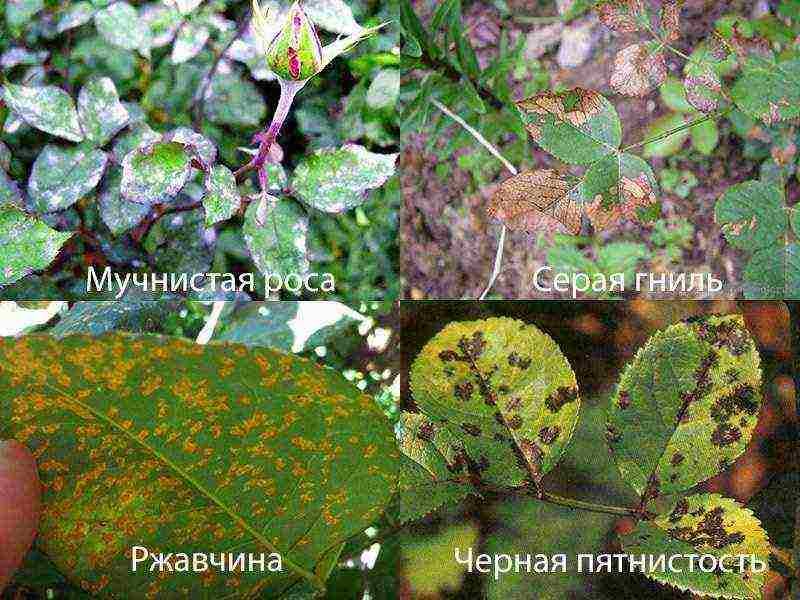
- Rust... It appears in April-May in young plants. Orange-yellow hillocks appear on the shoots and leaves. Affected leaves fall off, shoots dry out. Affected stems should be trimmed and burned. Treat with copper-soapy solution or wormwood decoction.
- Gray rot... Fungal disease that affects the stems and leaves - they show a characteristic fluffy bloom. The buds begin to rot, the leaves fall off. Affected shoots are removed, the rose is treated with a copper-soap emulsion or 0.2% foundationol solution.
Important! Most fungi develop in wet and rainy weather. Also, too much watering of the plants contributes to the appearance of the disease.
An excellent video about the treatment of rose diseases:
How to treat roses from pests
To eradicate pests, it is necessary to carry out 2-3 treatments with an interval of 3 days. Contact or systemic insecticides are used: Fundazol, Fufanon, Aktara, Actellik, Fitosporin and others. Also helps a copper-soap emulsion, a soap-kerosene solution (for 10 liters of water, 300 ml of kerosene and 100 g of soap), decoctions of garlic, tobacco. Caterpillars and beetles must be removed manually, branches affected by small pests are best cut and burned.
The main varieties of roses
Every year all appear new hybrids flower.Their diversity is striking: from dwarf bushes to liana-like varieties that form garlands of roses.
Depending on the variety, roses are grown in standard or bush form, using them to decorate flower beds and borders. Weaving are suitable for decorating walls, arches, pergolas, ground cover - for landscaping slopes.
Climbing rose varieties
These roses have creeping shoots, 3-15 meters long, small (2-5 cm) flowers. Basically, the aroma of climbing roses is weak, flowers are collected in inflorescences. Flowering occurs in the first half of summer. Most varieties are hardy and winter well. Climbing roses are divided into 2 subcategories: small-flowered (ramblers) and large-flowered (climber).
The most popular varieties:
- Bobbie james... Creamy white roses, bush height reaches 8 meters, width - up to 3 meters. The aroma of flowers is intense, musky.

- Super dorothy... The height of the bush is 2.5 meters, the flowers are bright pink, collected in inflorescences. The aroma is weak.

- Snow goose... The bush grows up to 3 meters, blooms profusely with white flowers collected in a brush. Almost odorless.

- Elf... The height of the bush is up to 2.5 meters. Roses are greenish-white, densely doubled and large (up to 14 cm in diameter). The aroma is fruity.
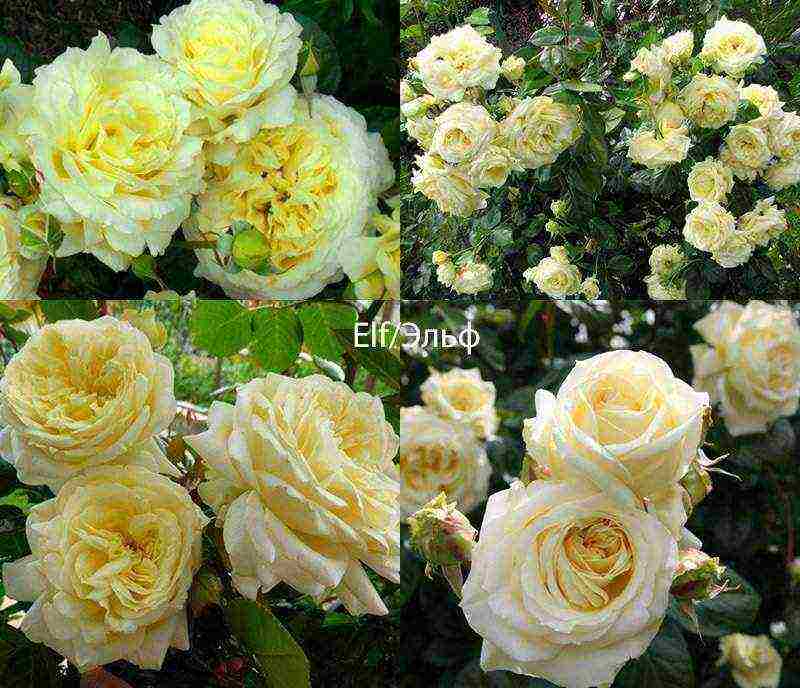
- Indigoletta... It reaches a height of 3 meters. Lilac double flowers, up to 10 cm in diameter. The scent of rose oil with fruity notes.

Rose varieties for the Moscow region
When choosing varieties, one should take into account the endurance and frost resistance of varieties, since the Moscow region is located in the Middle Lane. We recommend paying attention to hybrid tea and climbing roses:
- Florentine... The bush grows up to 2 meters, blooms with red flowers, collected in inflorescences. Aroma with light fruity notes. High frost resistance, this variety belongs to non-covering types of roses.

- Super Excelsa... Climbing rose, up to 2 meters high. Flowers - bright crimson, double, collected in large brushes. Blooms throughout the summer. Light scent of myrrh. Very winter hardy.

- Polka Casino... Climbing roses, 3-4 meters high. Lemon yellow goblet flowers, light fruity aroma. Blooms 2 times per season, high frost resistance.
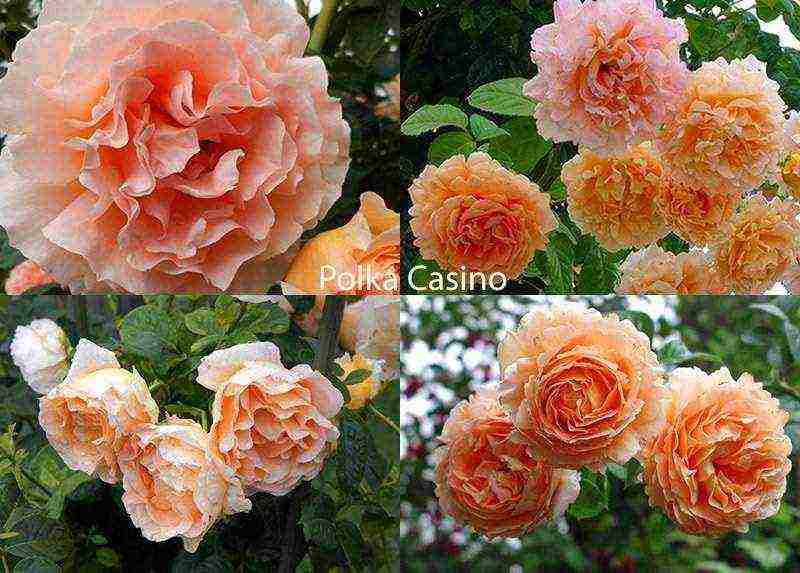
- Gloria dei... The height of the bush is 1.2-1.8 meters. Bicolor buds with a smooth transition from light yellow to pink with a raspberry border. The aroma is honey-fruity.
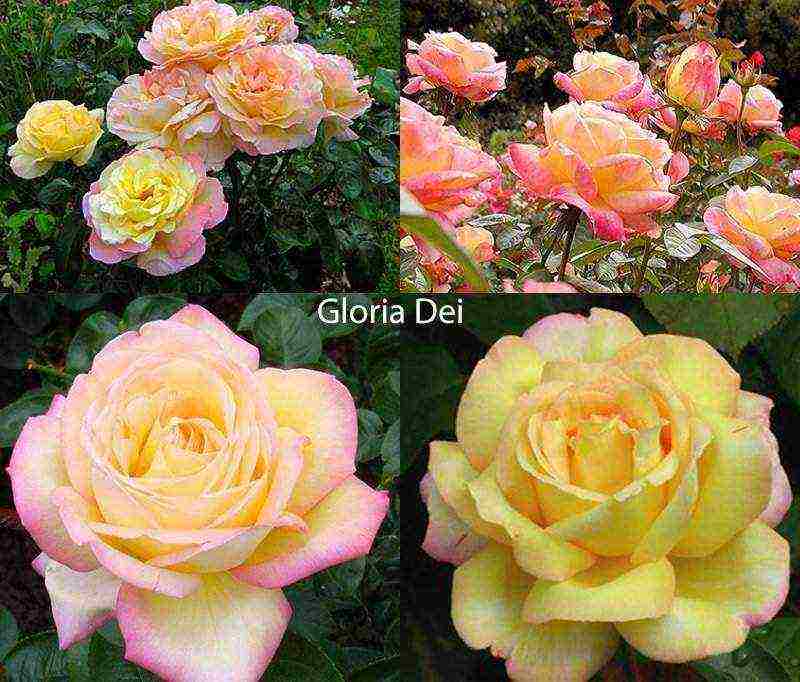
- Rhapsody in blue... Ideal for exotic lovers. The height of the bush is 1.2-1.5 m. Purple flowers of an unusual shape with a very light core. Intense fruity aroma with citrus notes.
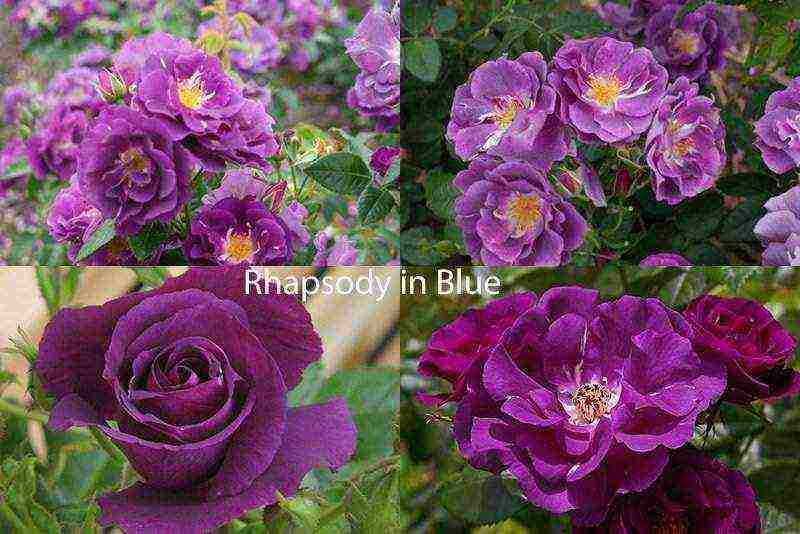
Winter-hardy varieties of roses
Frost resistance is a valuable quality for roses planted in our conditions. TOP 5 most popular varieties:
- Golden Celebration... Classic hybrid tea variety, bush height up to 80 cm. Large velvet-terry honey-amber shade. The rose has a light fruity aroma with hints of oriental spices.
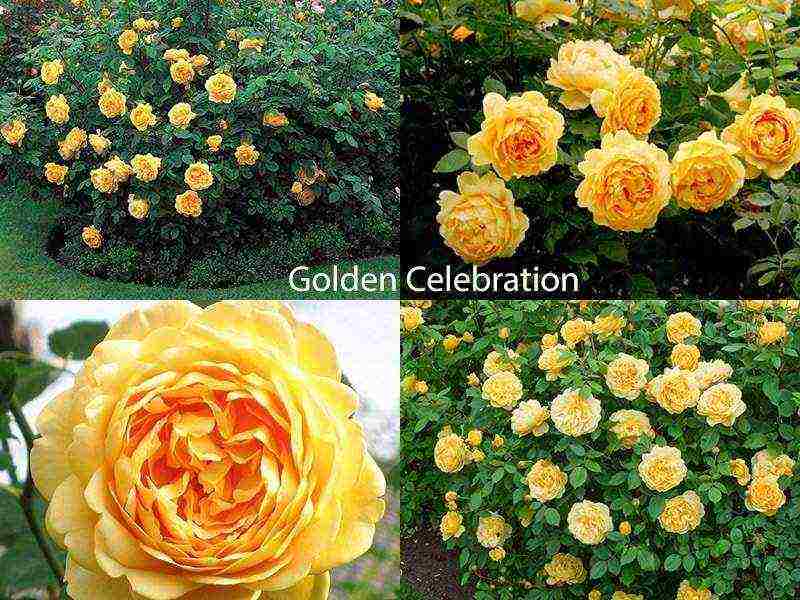
- Queen elizabeth... The height of the bush is up to 180 cm. Delicate pink flowers are collected in inflorescences. The aroma is delicate fruity.

- Black magic... Erect bushes, up to 1 meter high. The flowers are maroon, almost black, 8-9 cm in diameter. The aroma of rose oil is light.
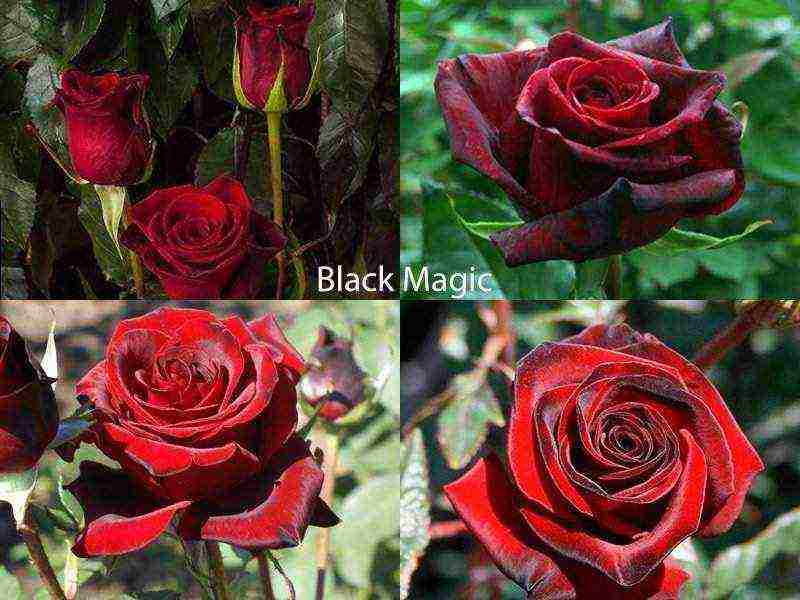
- William shakespeare... The height of the bush is up to 1 meter, the shades of flowers are from deep red to purple. The aroma is sweet with spicy notes.
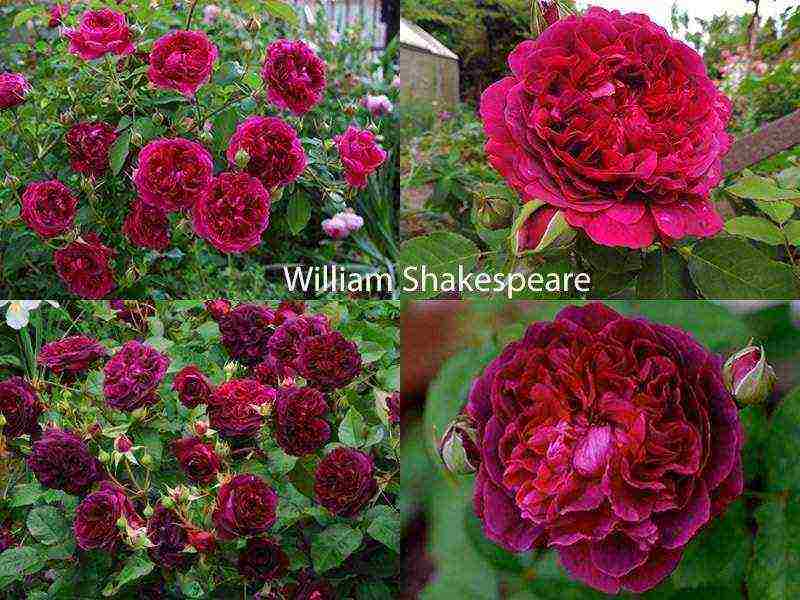
- Rosarium Uetersen... The height of the bush is up to 2 meters, bright pink dense double flowers, up to 13 cm in diameter. Intense aroma with an apple note.

Hybrid rose varieties
Hybrid tea roses bloom from June to late autumn. The bushes are both spreading and pyramidal in shape, the flowers are quite large. Popular varieties:
- Alex red... Bush up to 2 meters high. Terry cherry-red color, 14-17 cm in diameter. Pleasant fruity aroma.

- Gloria Day (Gloria Dei)... Bush, 1.2-2 meters high. The flowers are golden yellow with a pinkish edging, 15 cm in diameter. The aroma is weak, sweetish.
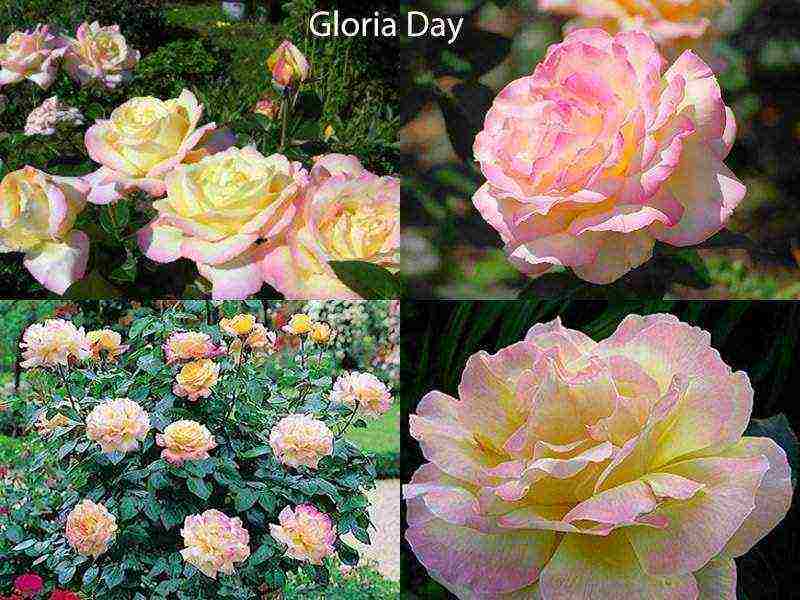
- Nicole... The height of the bush is up to 80 cm. The white-pink core of the color is framed with dark red petals. The diameter of the flower is 8-10 cm. The aroma is not too persistent, with sweet notes.
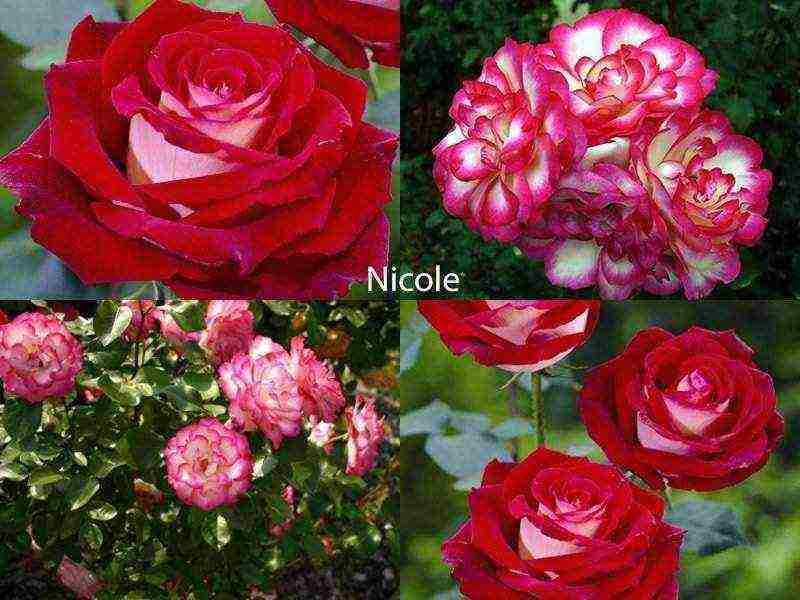
- Yellow rose of texas... Bush, up to 130 cm high. Apricot-colored flowers grow up to 14 cm. With a light fruity aroma.
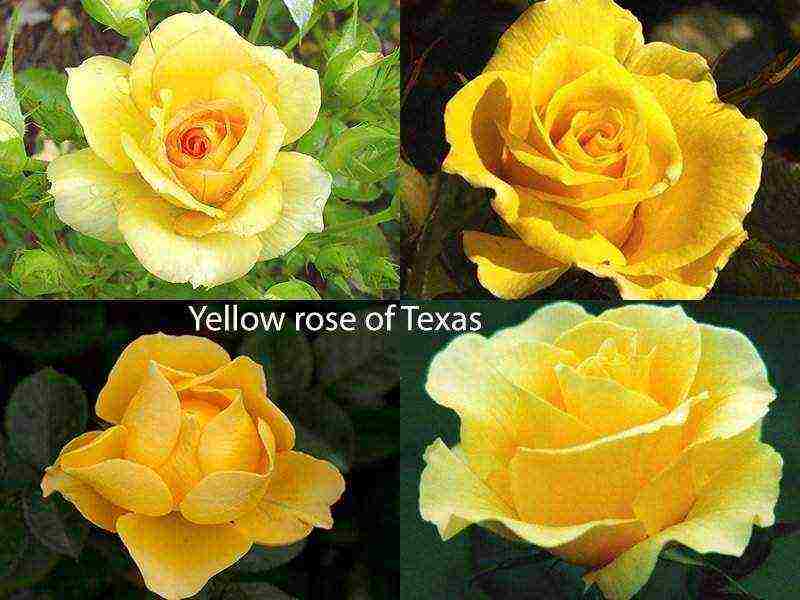
- Double delight... The height of the bush is about 120 cm.Large flowers, petals inside the bud are creamy white, outside - crimson. Sweet fruity aroma.
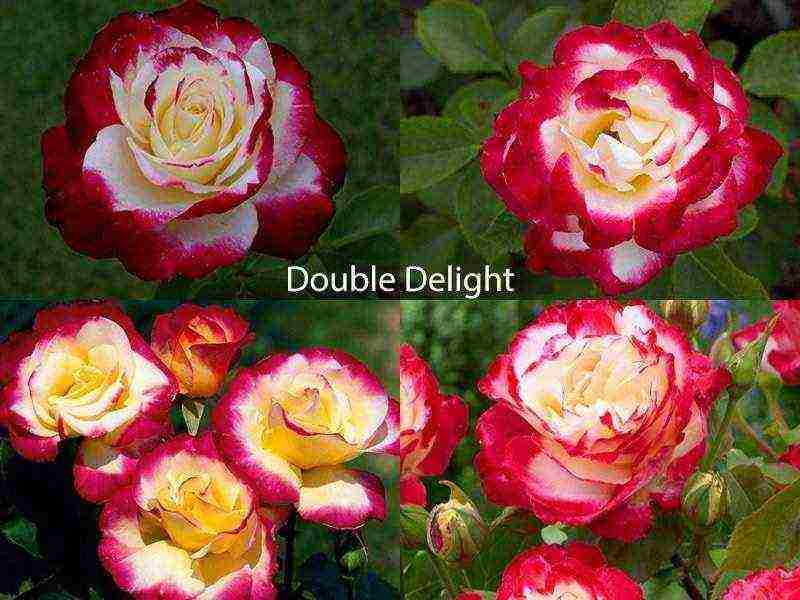
Ground cover varieties
This subgroup includes varieties with creeping or drooping shoots. The leaves are small, the shrubs are rich in color, most often the buds are collected in inflorescences. The height of the bushes is from 30 cm to 1.5 meters. Popular varieties for giving:
- Akhtiar... Powerful shrub, up to 1.2 m high. Flowers are white, double, up to 10 cm in diameter. Strong pink aroma.

- Ballerina... The height of the bush is up to 90 cm. The flowers have a white heart and pink petals, the diameter is 4-5 cm. The aroma is stable, with musky notes.
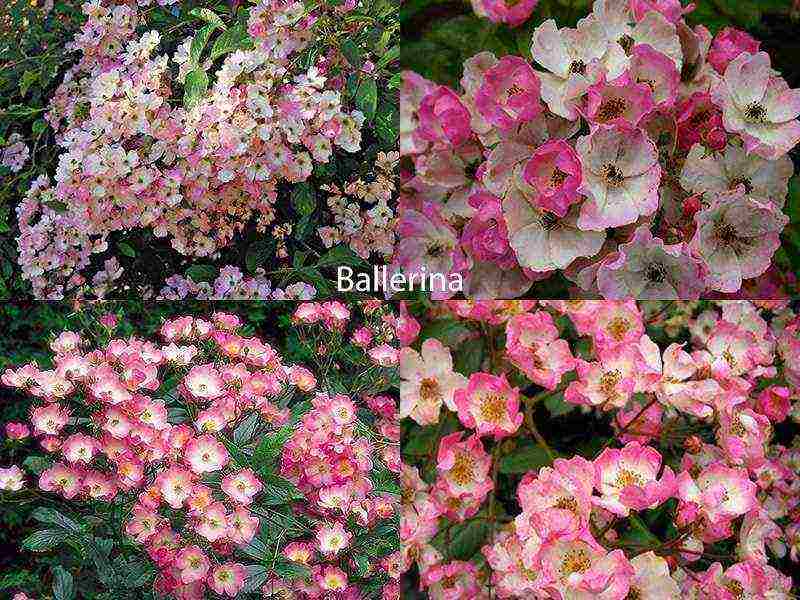
- Amber viel... The height of the shrub is 70 cm. The flowers are amber-apricot in color, their spherical shape is remarkable. The aroma is mildly spicy.

- Stadt rom... Low bushes, up to 50 cm high. Flowers of a pastel-salmon shade, do not fade even in strong sunshine. Low fruity aroma.

- Ferdy... The height of the bush is 80 cm. The flowers are semi-double, bright pink, up to 5 cm in diameter. No pronounced aroma.
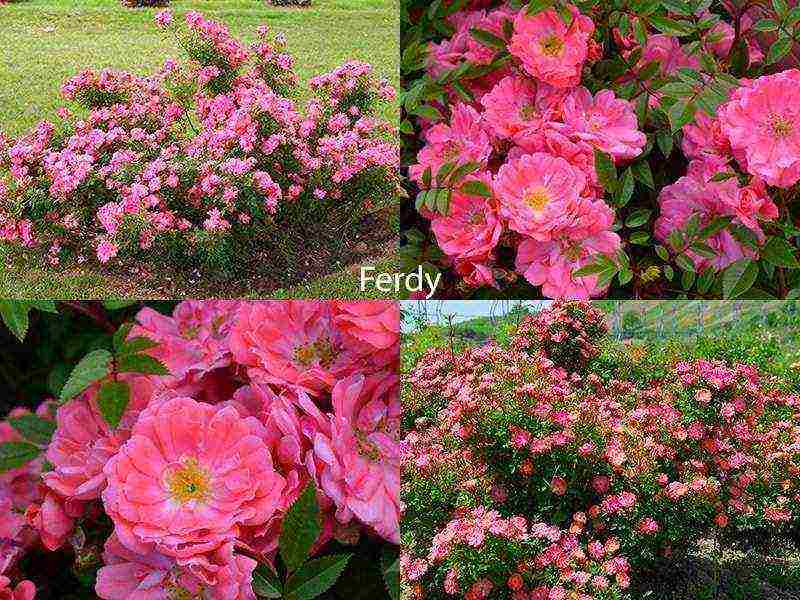
Canadian varieties
Perhaps, Canadian roses will be shown to someone not as spectacular as hybrid ones, but they have excellent winter hardiness and endurance. Most varieties do not need to be covered for the winter, they cut well and grow quickly. Canadian roses are divided into two subspecies: parkland (erect) and explorer (climbing). The most popular varieties:
- Quadra... The height of the bush is up to 1.8 m. Flowers are densely doubled, saturated red, up to 8 cm in diameter. No pronounced aroma.

- Felix leclerc rose... Climbing rose, up to 3 meters high. Semi-double flowers of a crimson hue. Light fruity aroma.
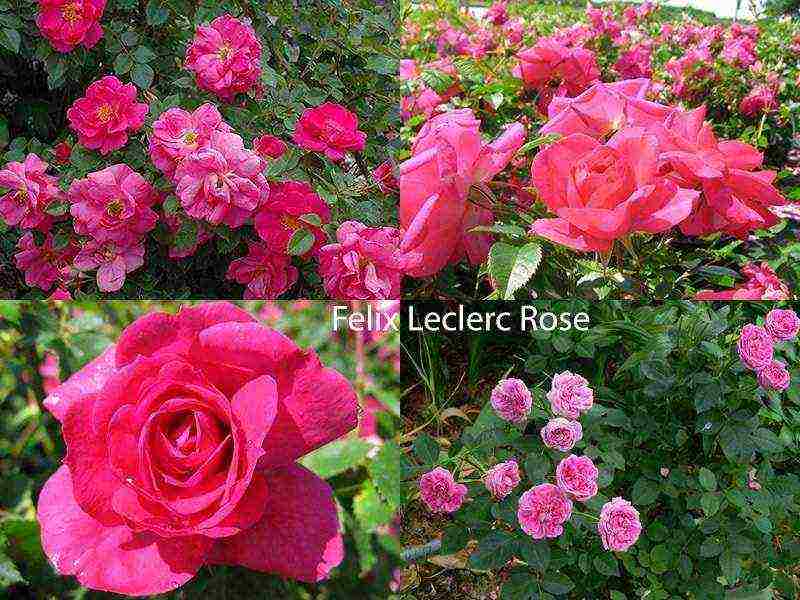
- Charles albanel... The bush looks like a ground cover rose, its height is up to 50 meters. Wine-red flowers, aroma with a tangible vanilla note.
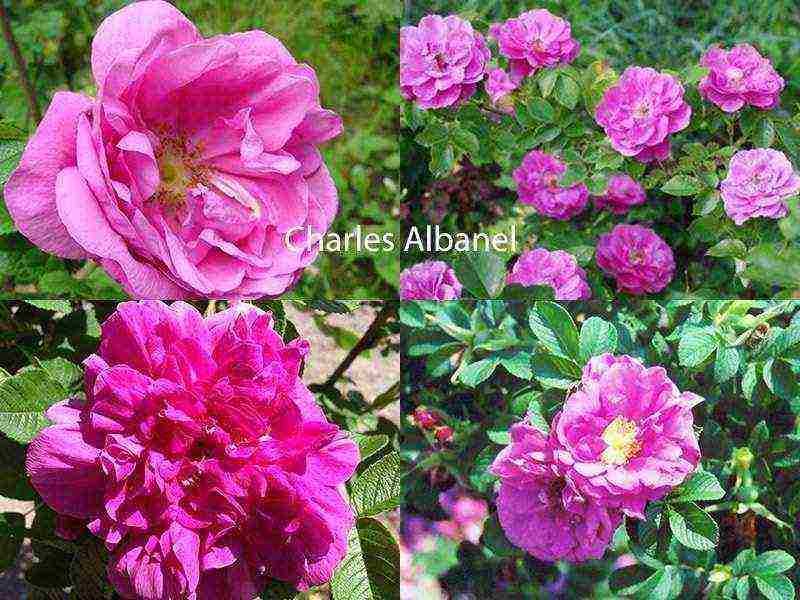
- Champlain... The bush reaches a height of 1 m. The flowers are semi-double reddish-pink. Light floral scent.
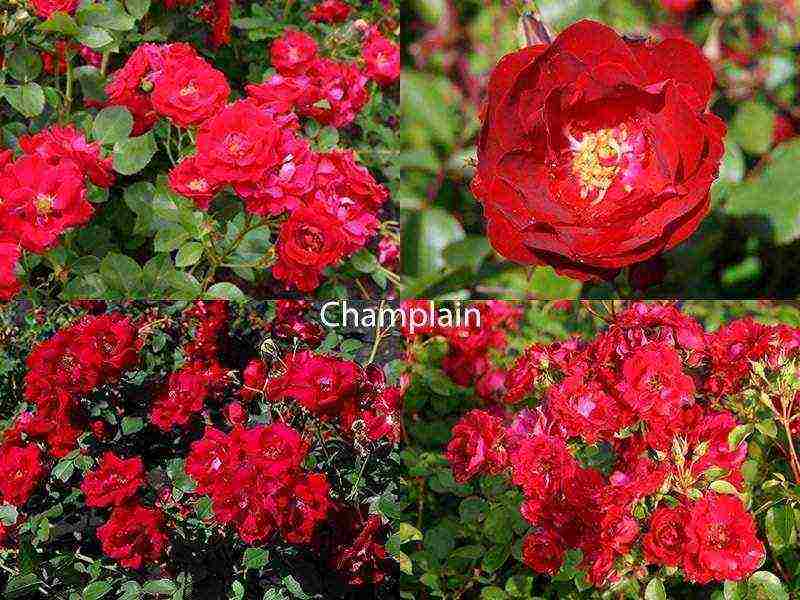
- Prairie joy... The height of the bush is up to 1.5 meters. Intense pink flowers, collected in inflorescences. The aroma is weak.

Varieties of tea roses
Tea roses are distinguished by a strong stem and large flowers with a characteristic aroma. There are both undersized (up to 60 cm) and climbing (more than 2 m) plants. The most popular types:
- Rose alexander... The height of the bush is from 1 to 2 meters. Large double red flowers, up to 10 cm in size. Aroma with hints of patchouli.

- Wienerwald (Wienerwald). The height of the bush is more than 80 cm. Salmon pink flowers with an orange sheen. The aroma is chocolate-strawberry.
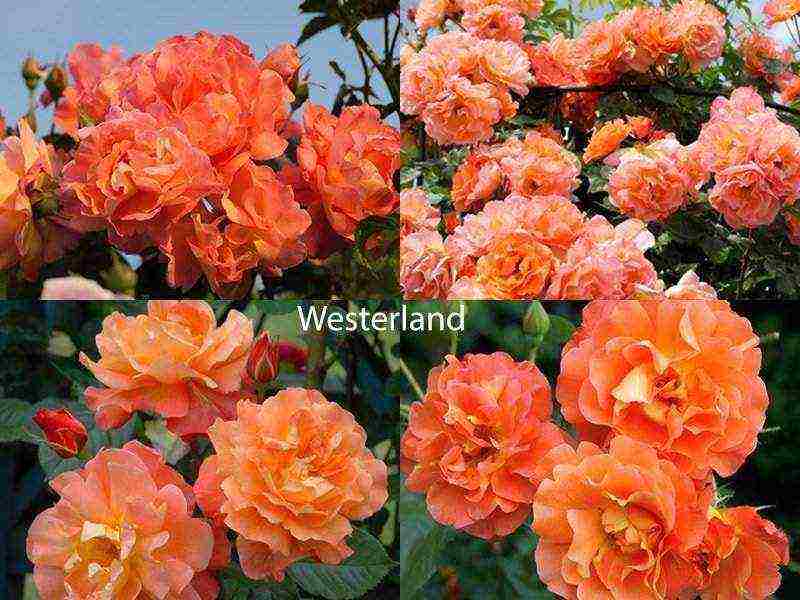
- Elina... The height of the bush is 1-1.2 m. Large creamy yellow flowers, which, depending on the weather, can change color. Pleasant fruity aroma.
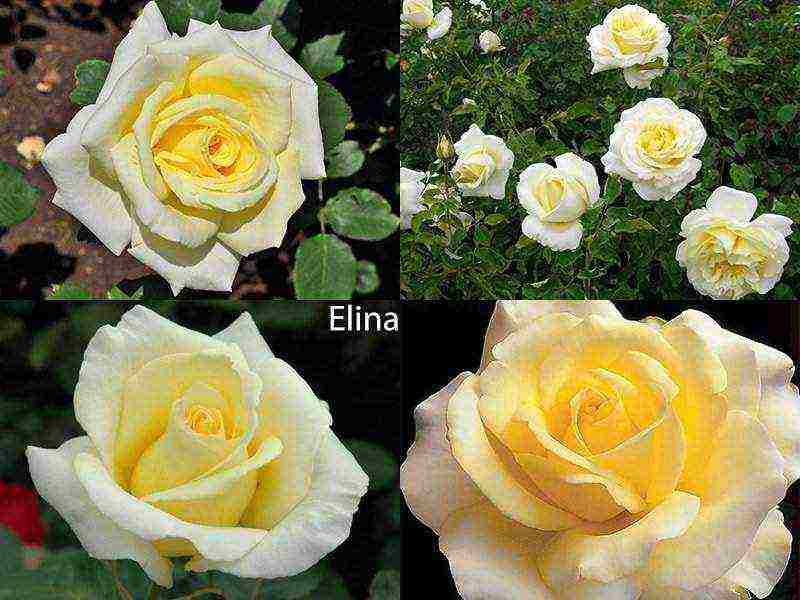
- Gloire de dijon... Bush, up to 5 meters high. Large salmon yellow flowers. The aroma is spicy with a hint of cinnamon.
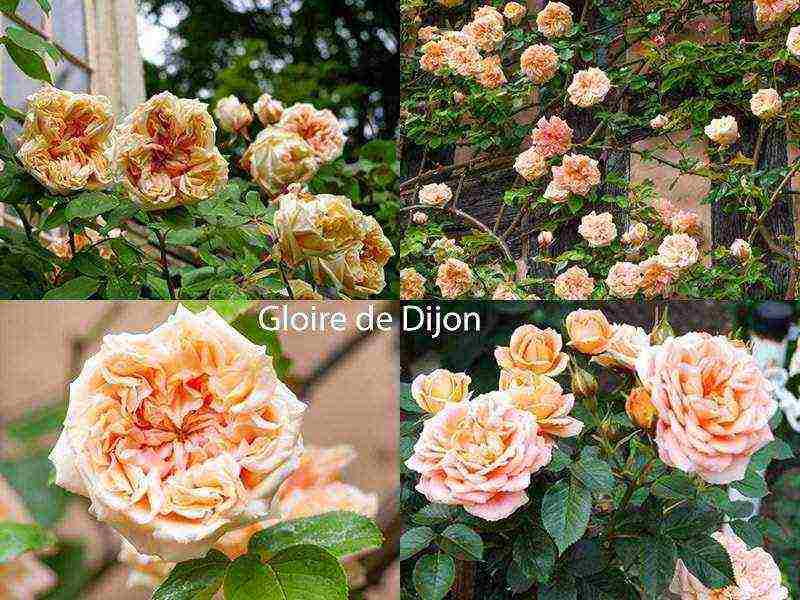
- Parade... The height of the bush can reach 3-4 meters. It blooms with bright pink large buds. The scent is similar to bergamot.
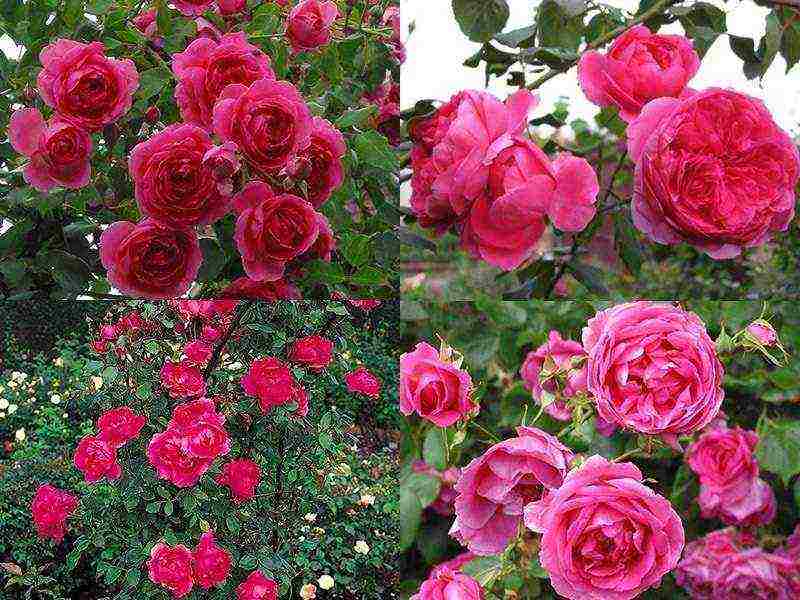
Floribunda roses
The shape of the flowers and inflorescences of floribunda are similar to hybrid tea roses. Rose bushes are quite spreading, buds are larger than ordinary garden roses. The smell is very subtle, almost imperceptible. What varieties to choose:
- Card blanche... The height of the bush is up to 1 meter. It blooms with medium-sized double flowers of bright white color. Flowering continues until late autumn. The aroma is weak.
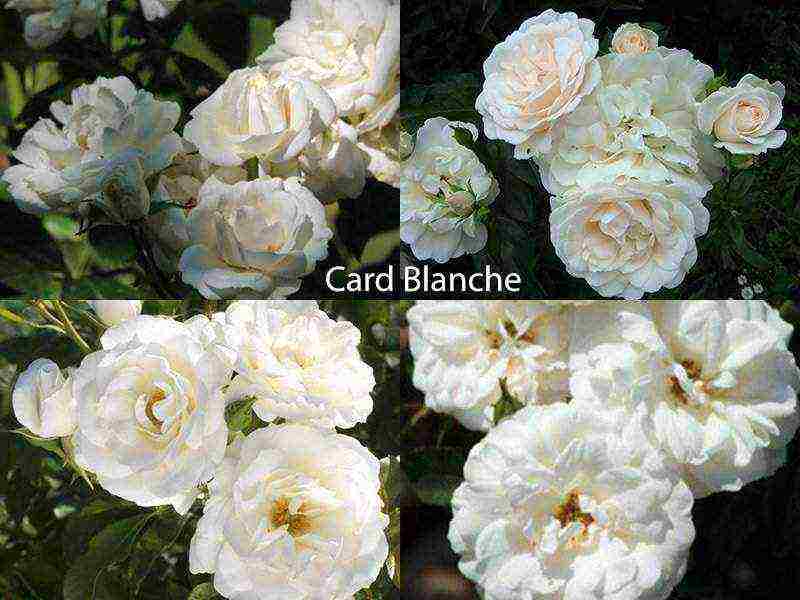
- Galaxy... The average height of the bush is 70-80 cm. Terry flowers are pastel yellow in color, with a red edging along the edges of the petals. The aroma is reminiscent of linseed oil.

- Sangria... The height of the bush is 0.8-0.9 m. The flowers are bright crimson, as if consisting of two tiers. Light aroma with fruity notes.
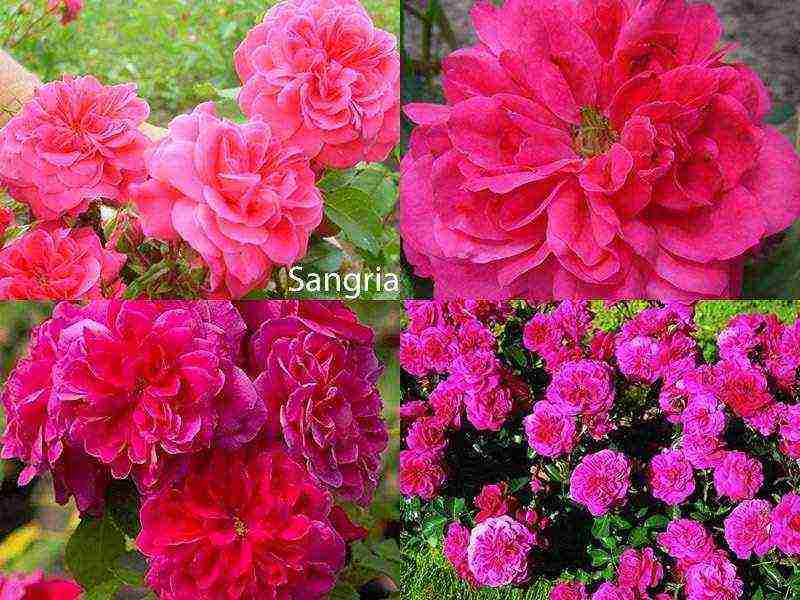
- Stromboli... The height of the shrub reaches 80 cm. Flowers are double, bright red, in inflorescences up to 10 buds. Faint floral aroma.
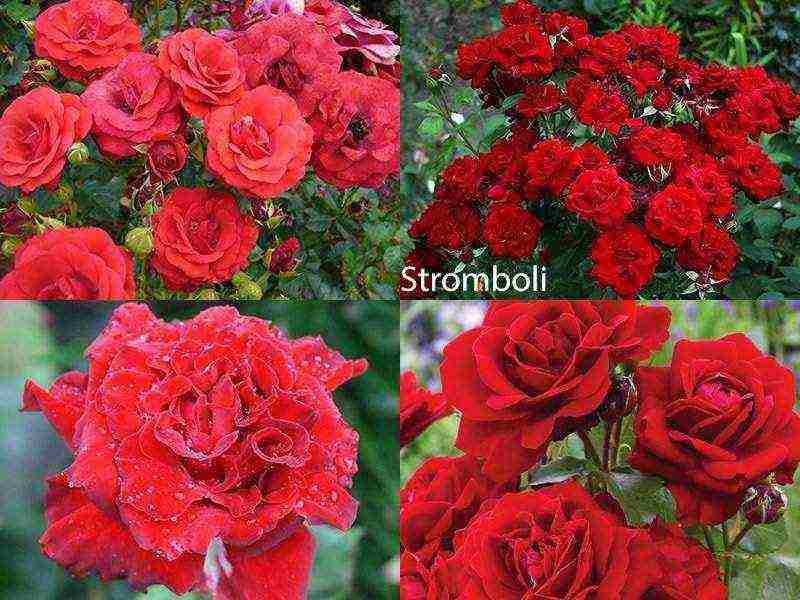
- Kimono... The height of the bush is up to a meter. Large crimson double flowers, in inflorescence up to 20 pieces. Almost odorless.
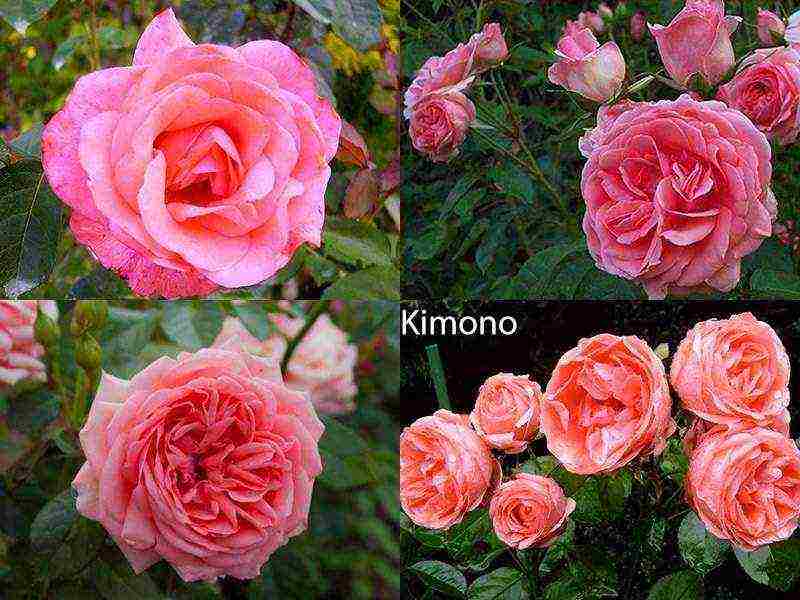
Austin roses
Austin roses or English roses were bred by crossing old roses with floribunda and hybrid tea. They have a strong aroma, long flowering period and amazingly beautiful flowers. Famous varieties:
- William morris... The height of an adult plant is up to 1.5 meters.Flowers can be pinkish or peachy, densely double. Perceptible tea smell.
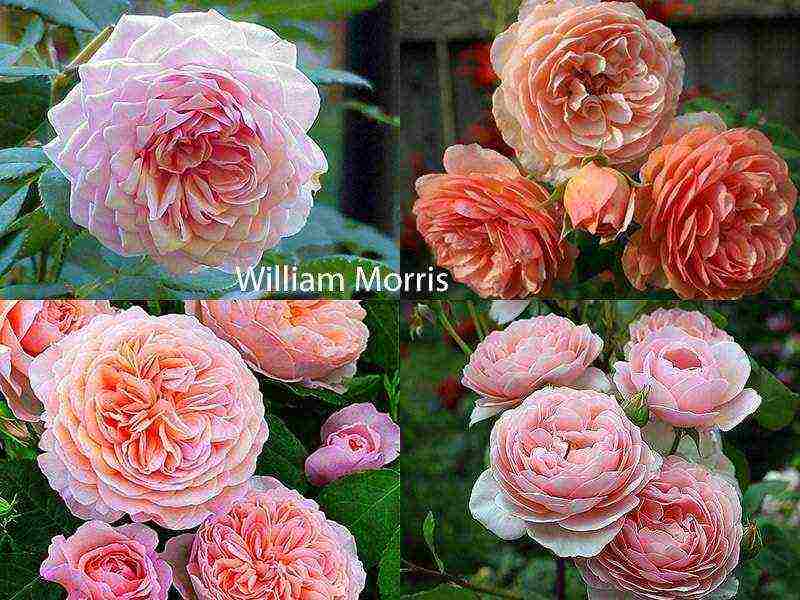
- Golden Celebration... Bush up to 1.5 meters high. Golden yellow flowers up to 16 cm in diameter. Fresh floral scent.
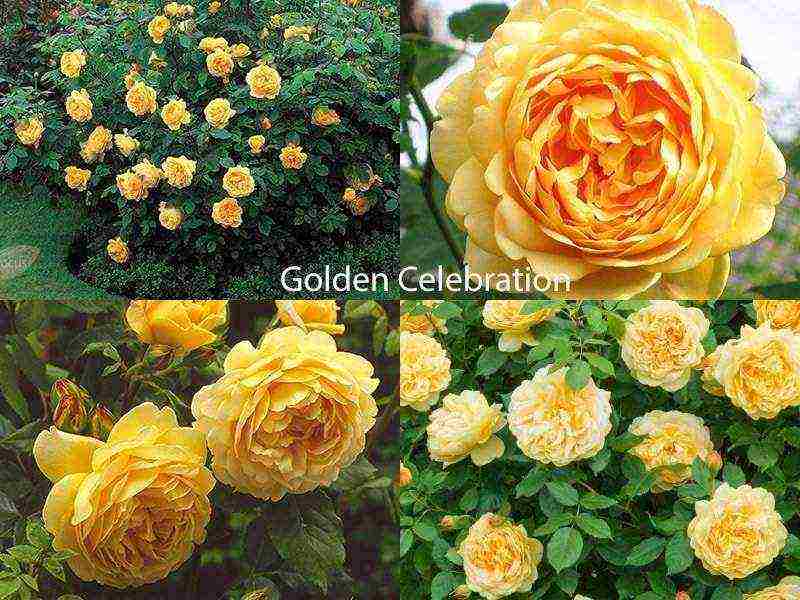
- James galway... The height of the bush is up to 1.5 meters. The flowers are pale pink, up to 0 centimeters in diameter. Delicate aroma of rose oil.
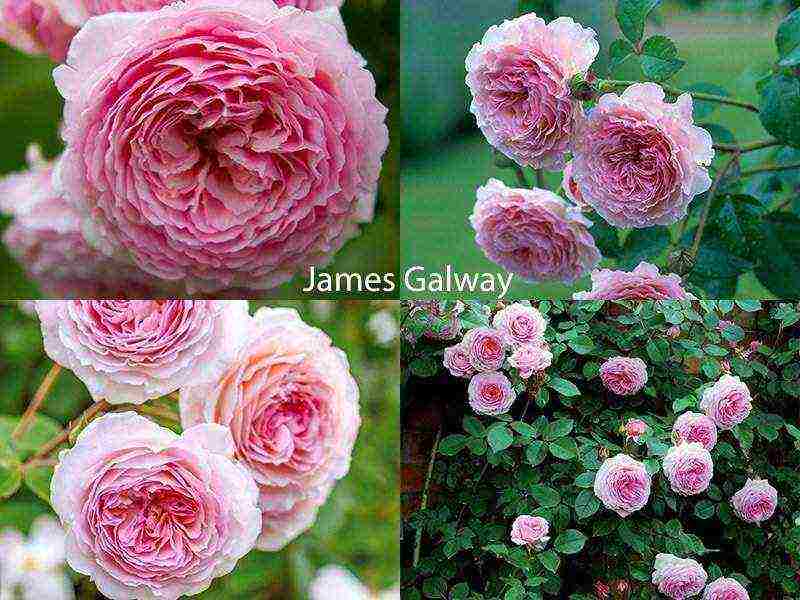
- Crocus rose... The height of the bush is 1.2-1.5 meters. The flowers are pale lemon or pure white, up to 10 centimeters in diameter. Delicate floral scent.
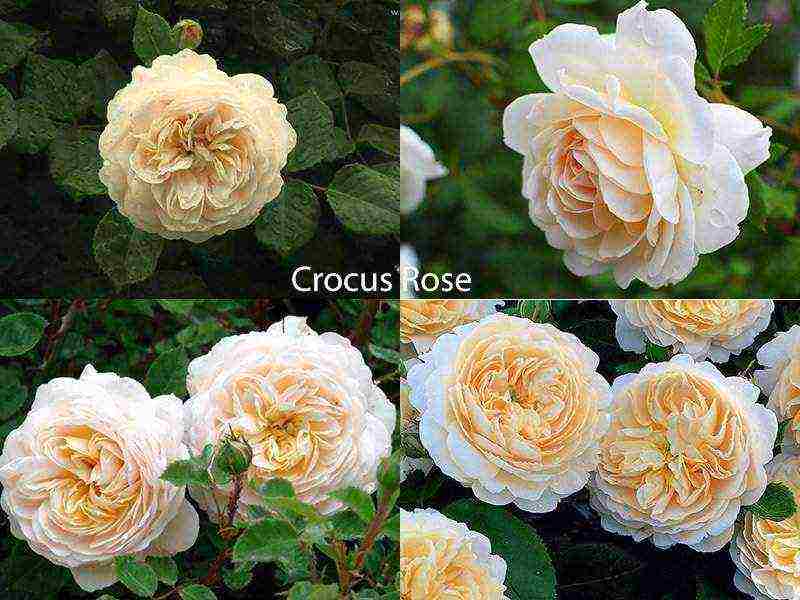
- Benjamin Britten... The variety is named after the composer. The height of the bush is up to 1.3 meters. Flowers are densely double, reddish-orange in color. The aroma is fruity.

Park roses
Park roses are also called old garden roses. They bloom all season, differ in large buds and unpretentious care. The following varieties are popular among gardeners:
- Remy martin... The height of the bush is 1.5 meters. The flowers are delicate apricot, up to 8 cm in diameter. The aroma with a delicate peach note.

- Lucia... The height of the shrub is up to 1.7 m. The flowers are lemon-yellow, collected in a brush. Delicate aroma with honey notes.

- Pilgrim... English roses, the height of the bush is up to 1.5 m. The core is lemon yellow, the petals are white and cream. Strong tea aroma with notes of myrtle.
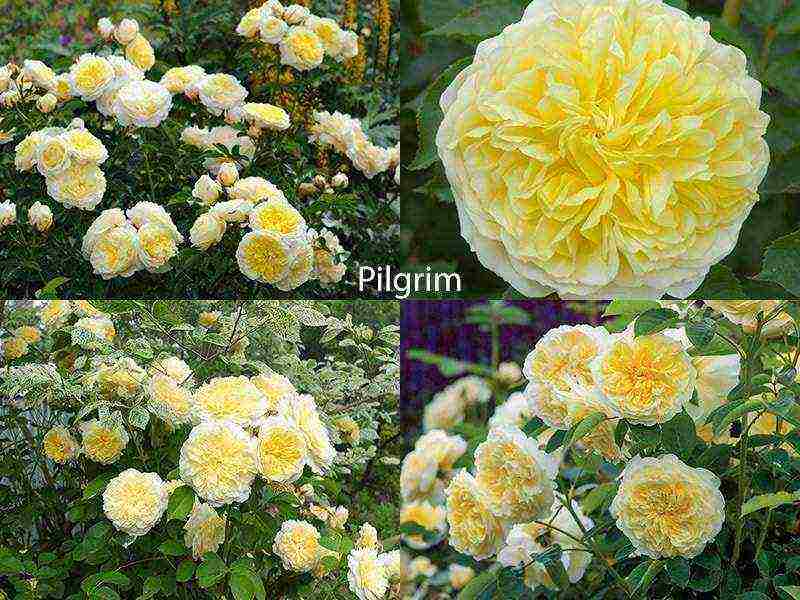
- Rose de resht... The height of the bush is up to 90 cm. The flowers are purple, up to 7 cm in diameter. The aroma is sweet.

- Westerland... Shrub height - up to 3.5 m. Flowers are deep orange in color, which fade to a delicate peach shade during the flowering period. Diameter - up to 12 cm. The aroma is strong, tart.

Interesting facts about roses
There are many interesting facts associated with roses:
- Rose oil is included in 98% of women's perfumery. To obtain 1 liter of rose oil, more than 3 tons of petals are required.
- In the collected works of Confucius, more than 600 volumes are devoted to roses.
- If you cross two roses with a strong scent, you can get a hybrid with a very faint scent.
- The rose flower was brought to Russia only in the 16th century; it was available only to high society.
- In Bulgaria, the Rose Festival is held annually in May. In this country, the flower is considered a symbol of happiness and prosperity.
- The real cult of roses was in ancient Rome. This flower was necessarily present at wedding ceremonies: the wedding bed was sprinkled with petals, and at feasts the nobility drank rose wine.
- Rose scent is considered a good antidepressant and has a hypnotic effect.

Roses will be a wonderful decoration for the wedding site, delighting the owners with long flowering and exquisite aroma!
If you liked the article, please share it on social networks using the buttons below! Thanks for the support!
The other day, thinking about the imminent arrival of spring, we made an amazing selection: TOP-10 seeds of unusual flowers (lilies, calla lilies, dahlias, hydrangeas, irises, clematis ...), which you can buy cheaply on AliExpress with free shipping.
